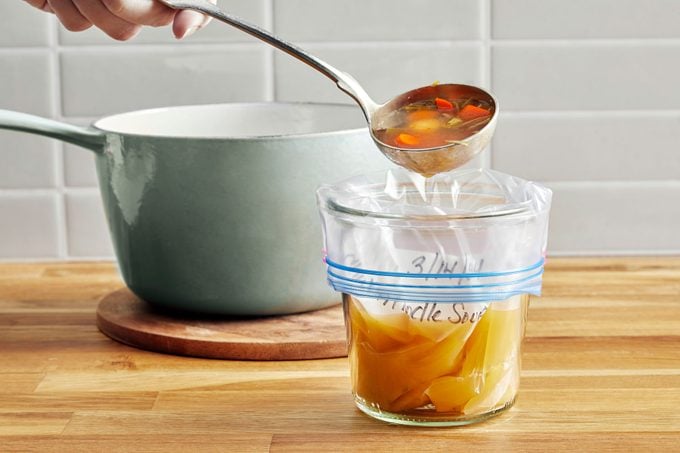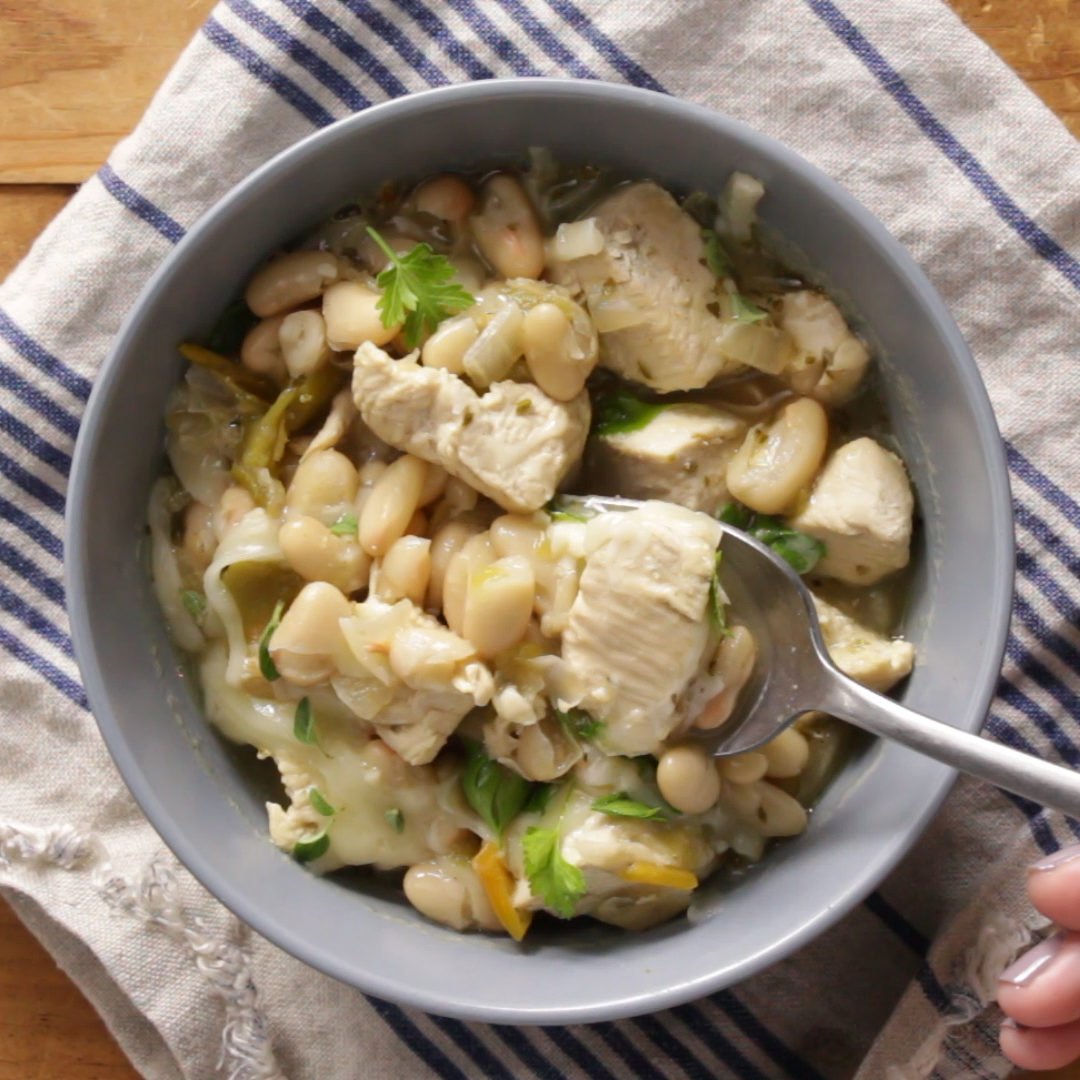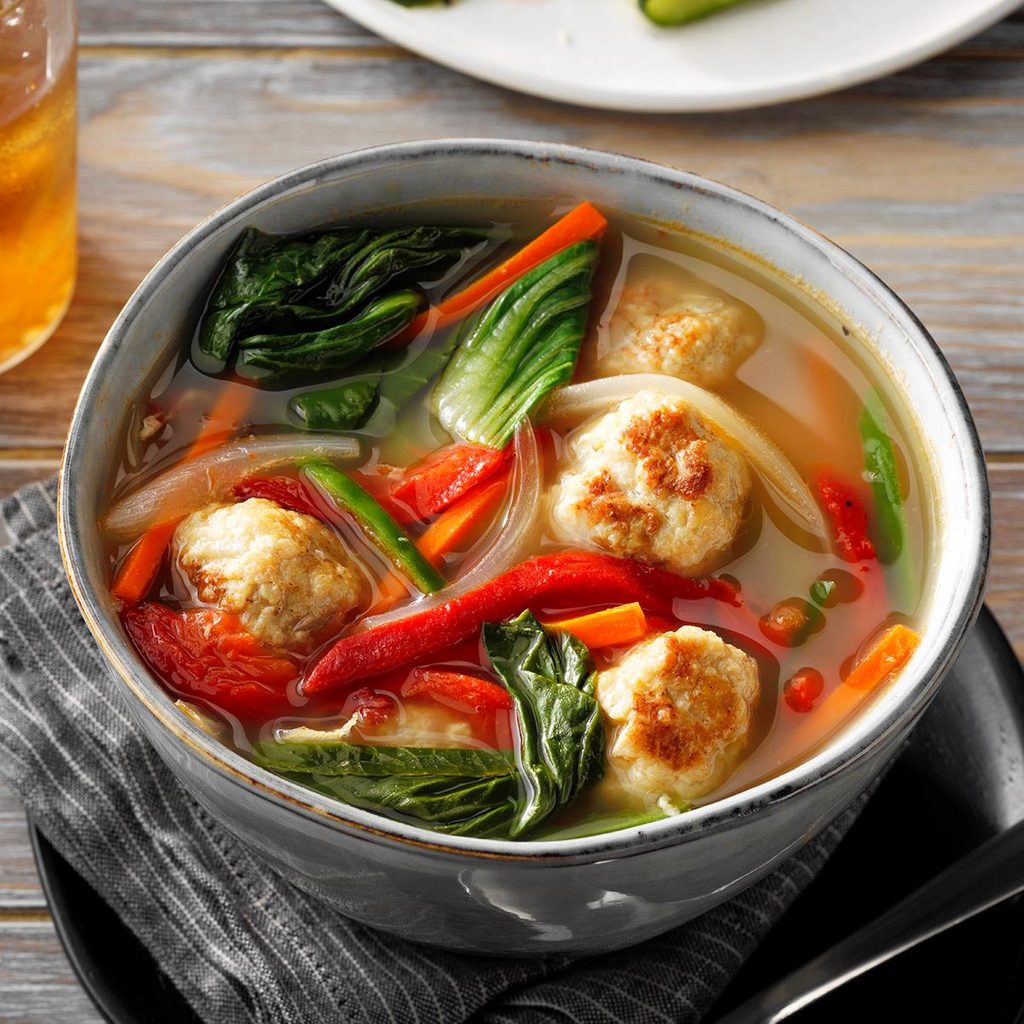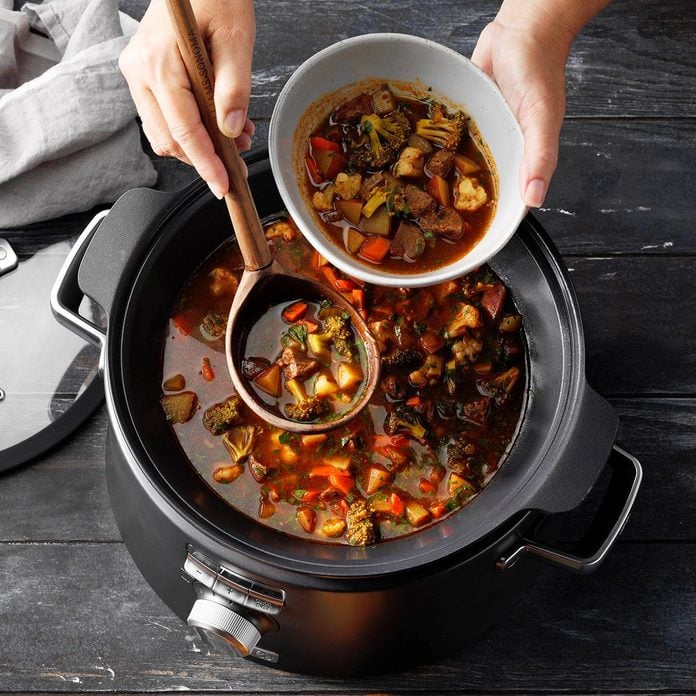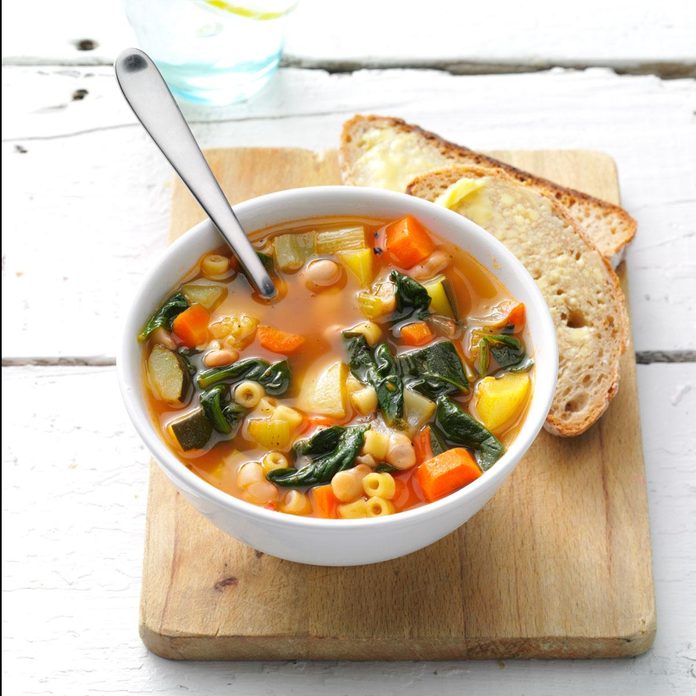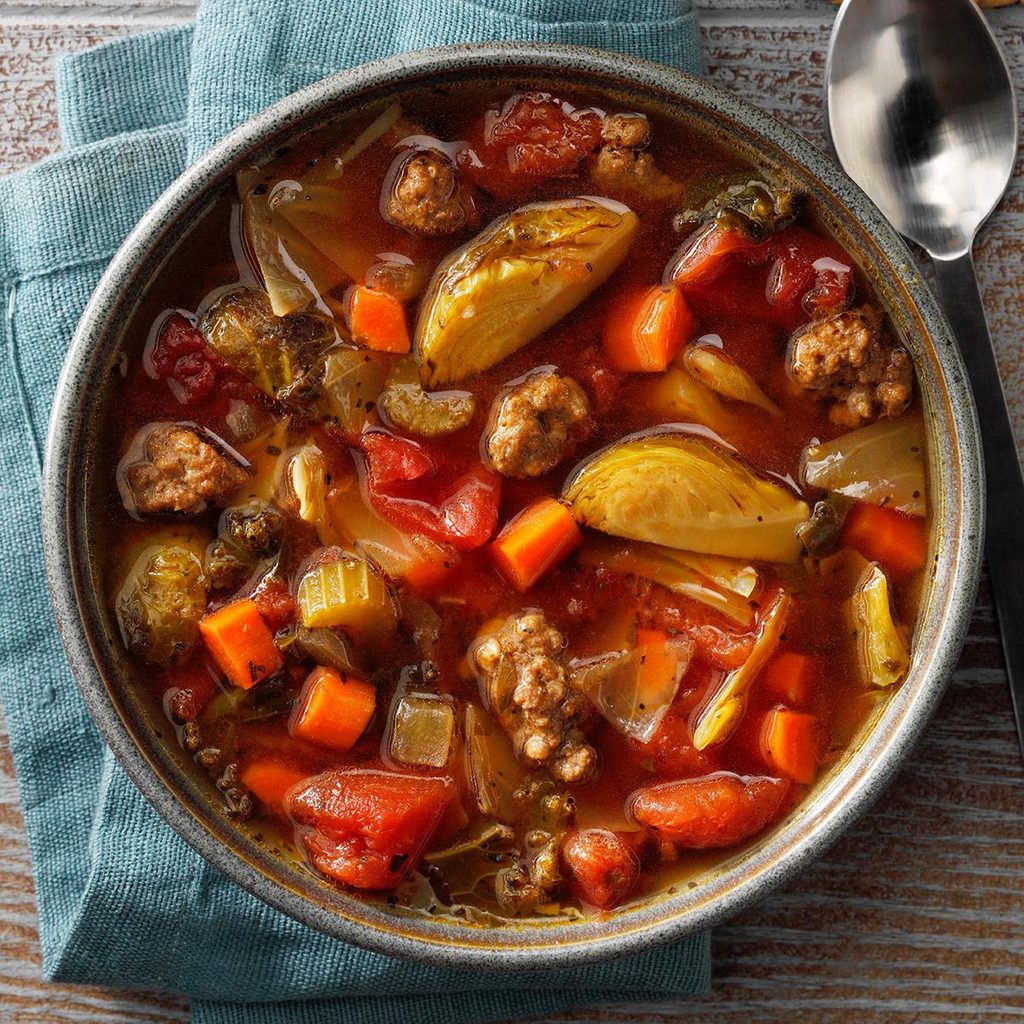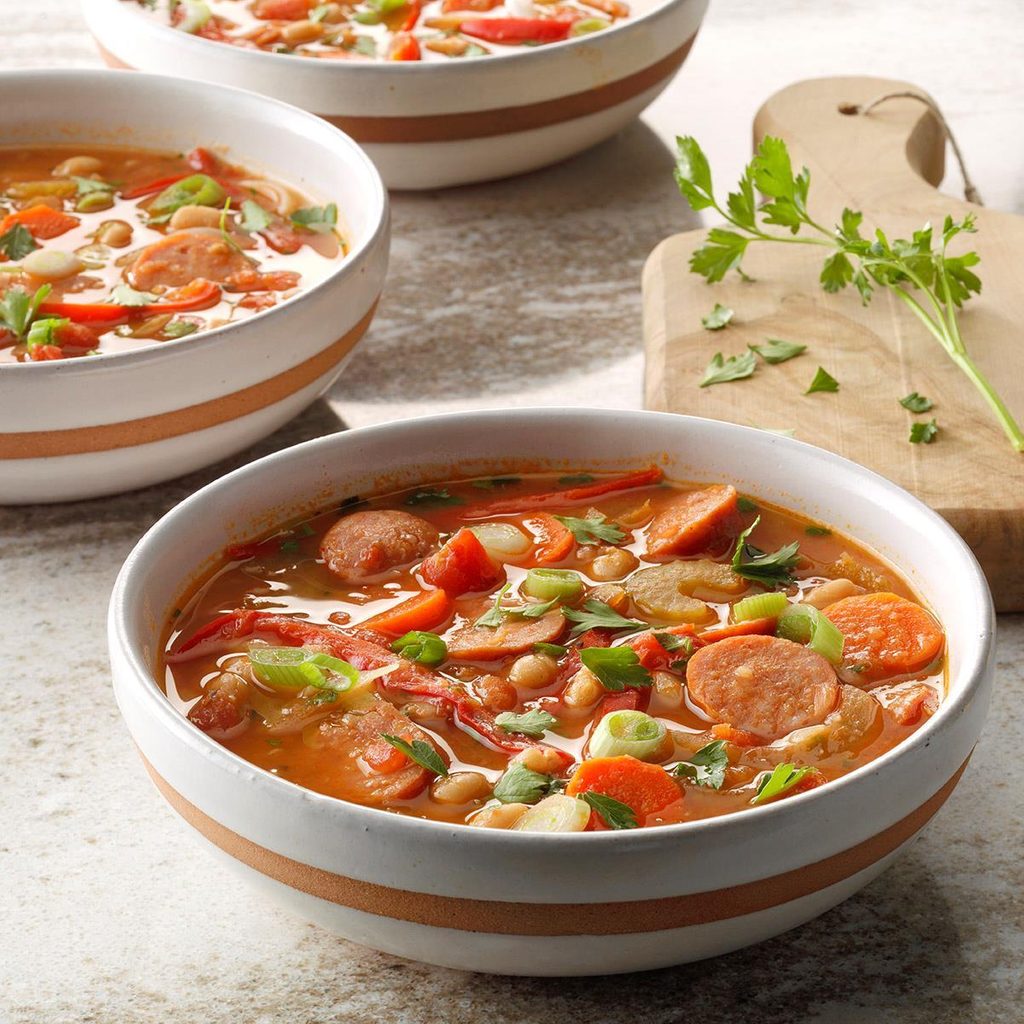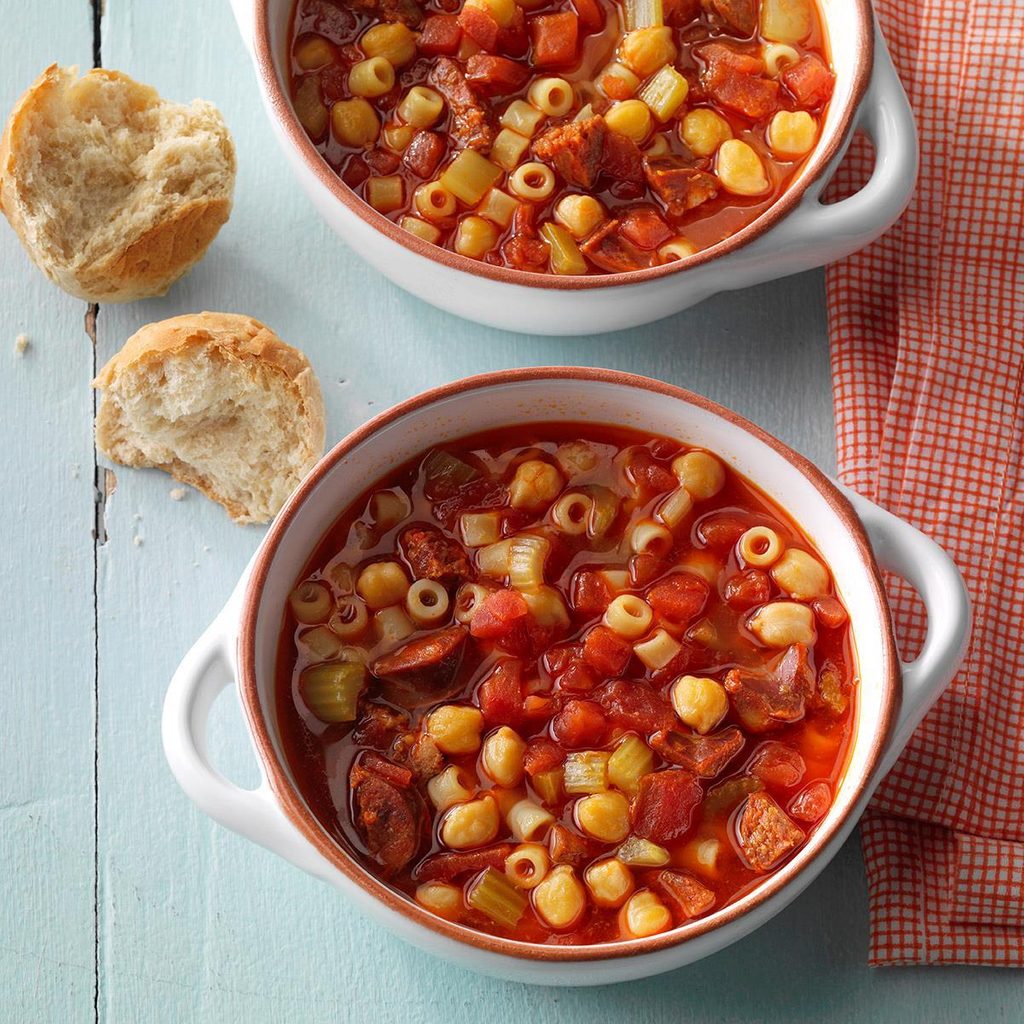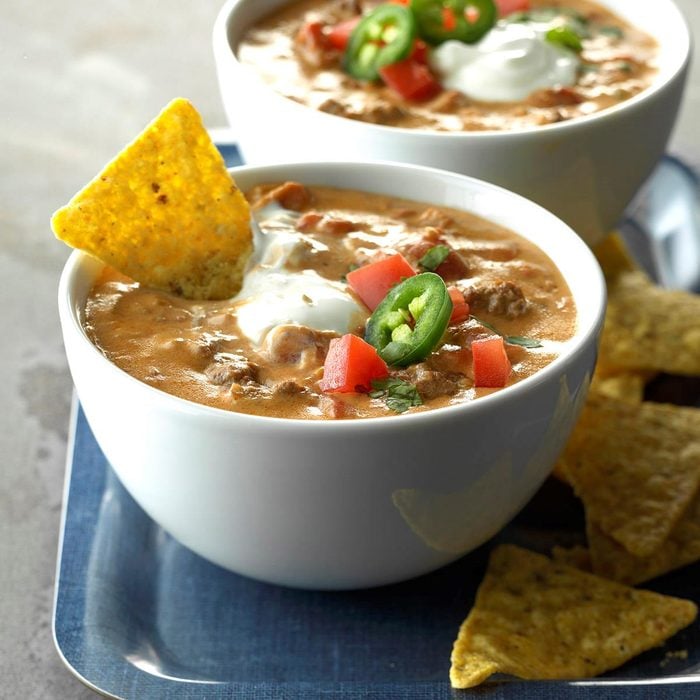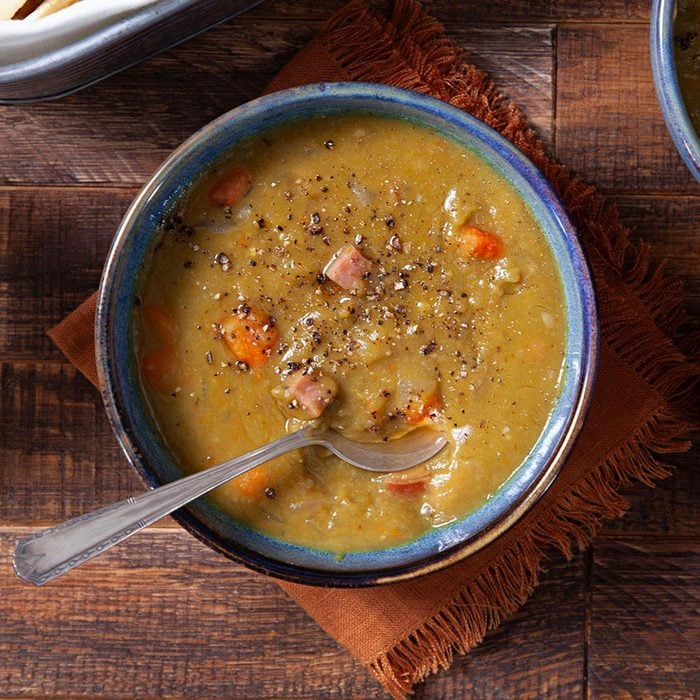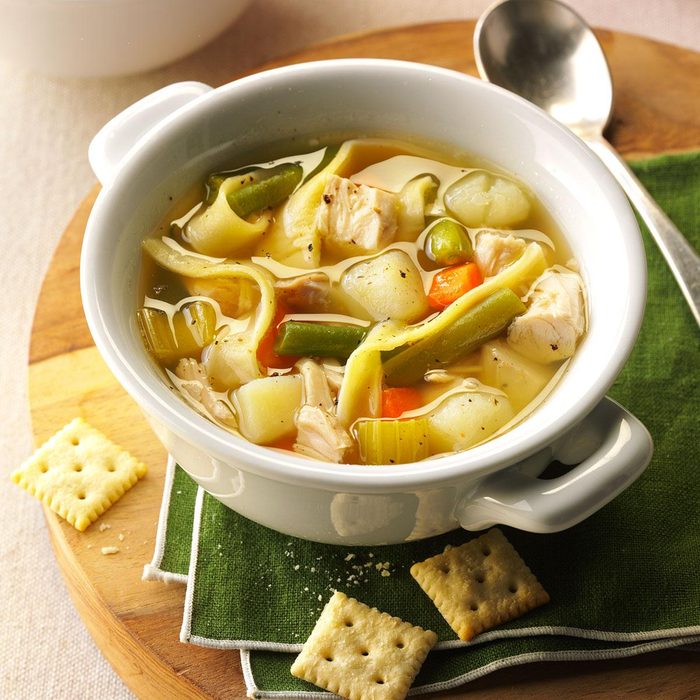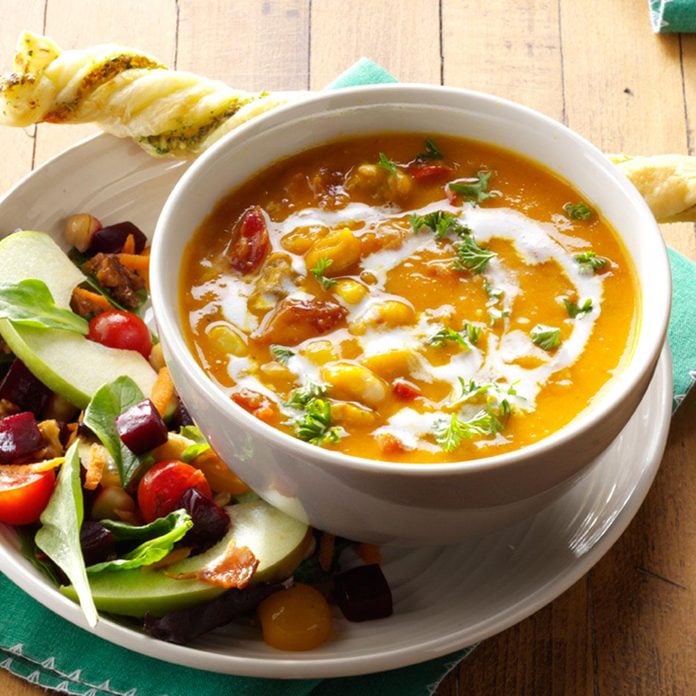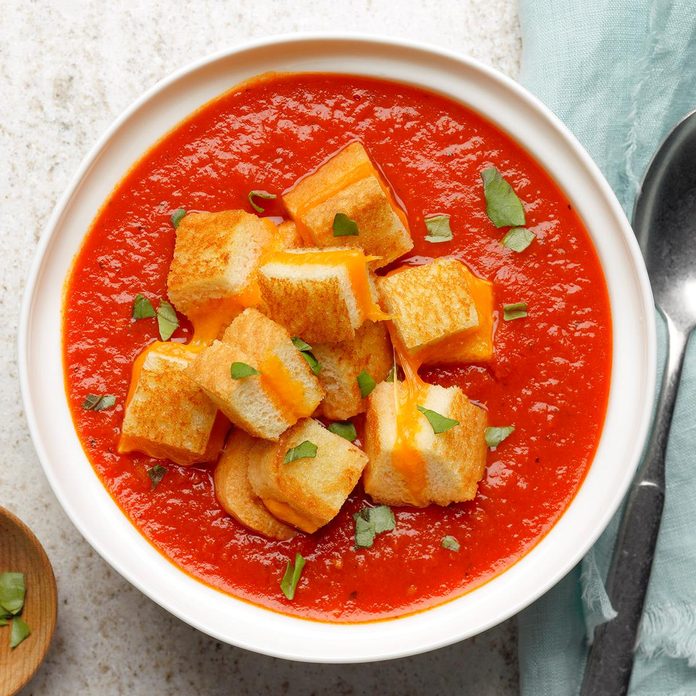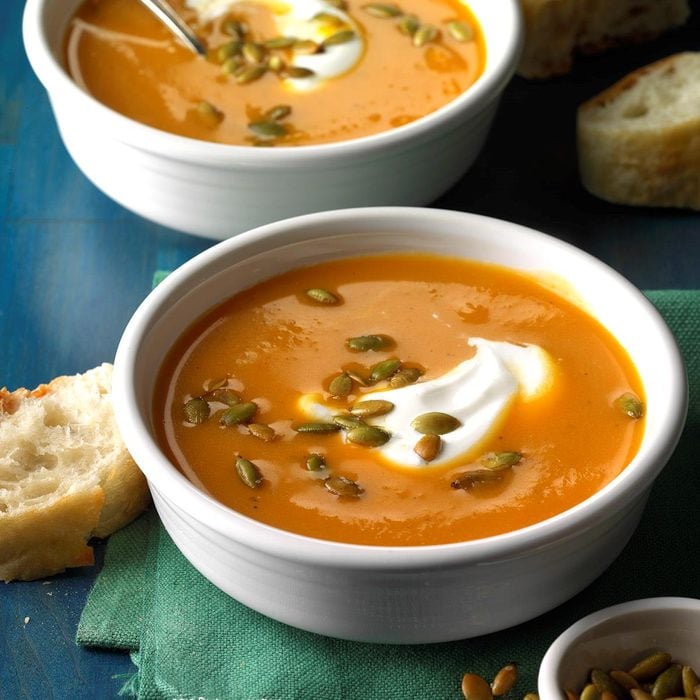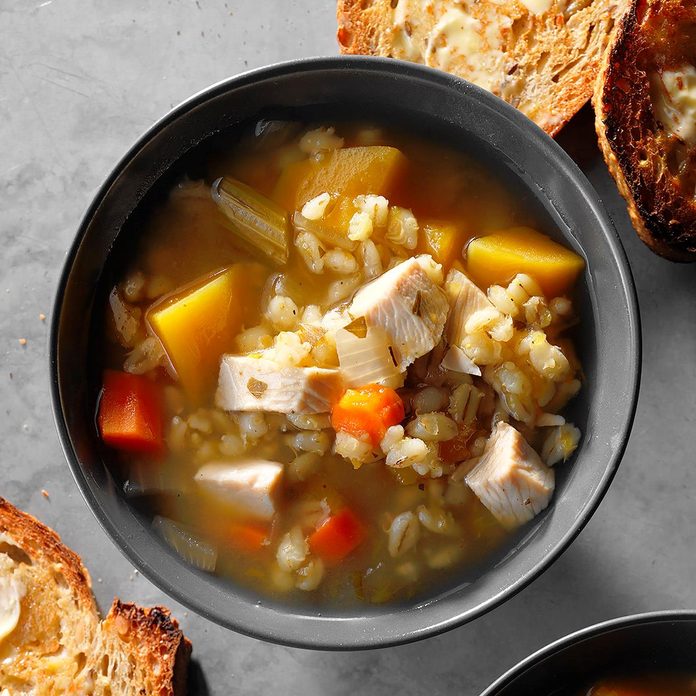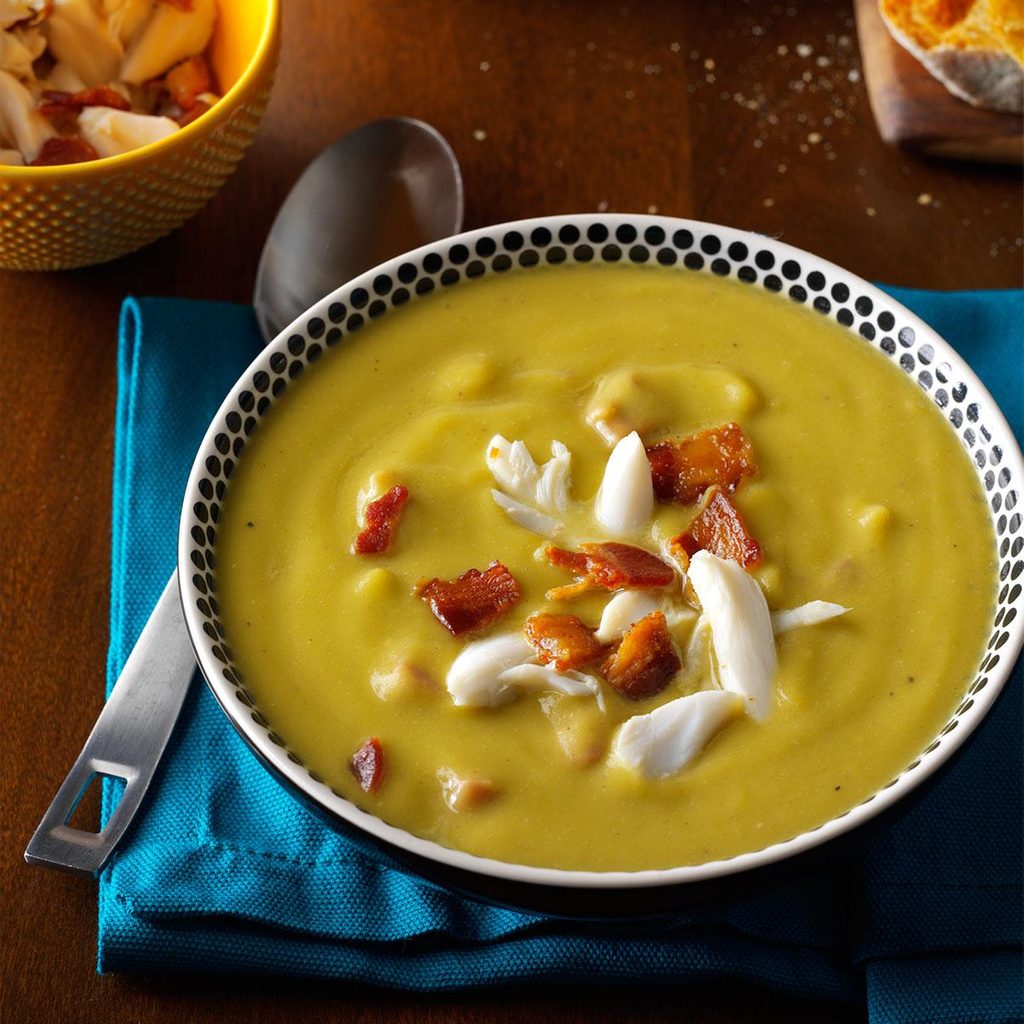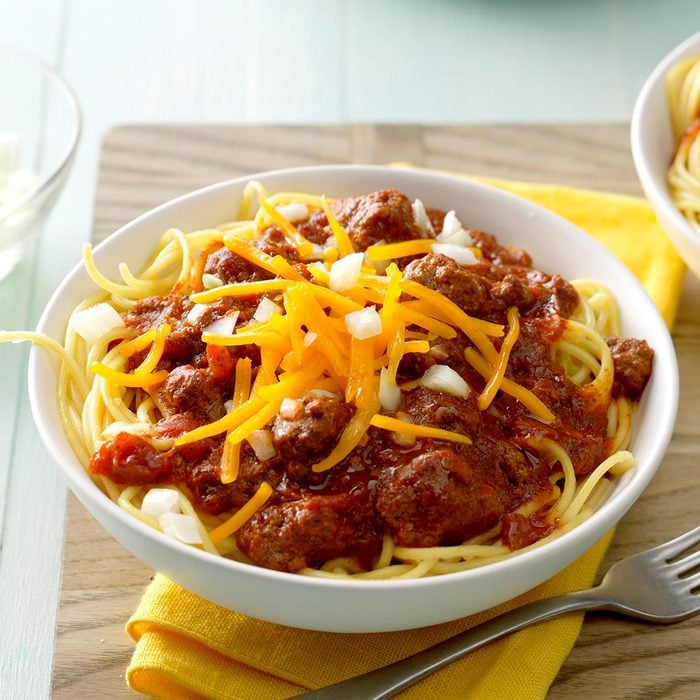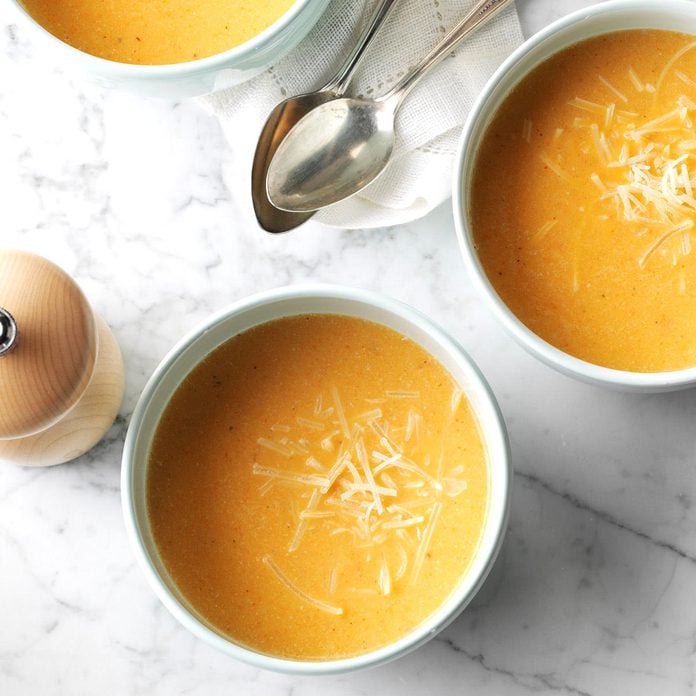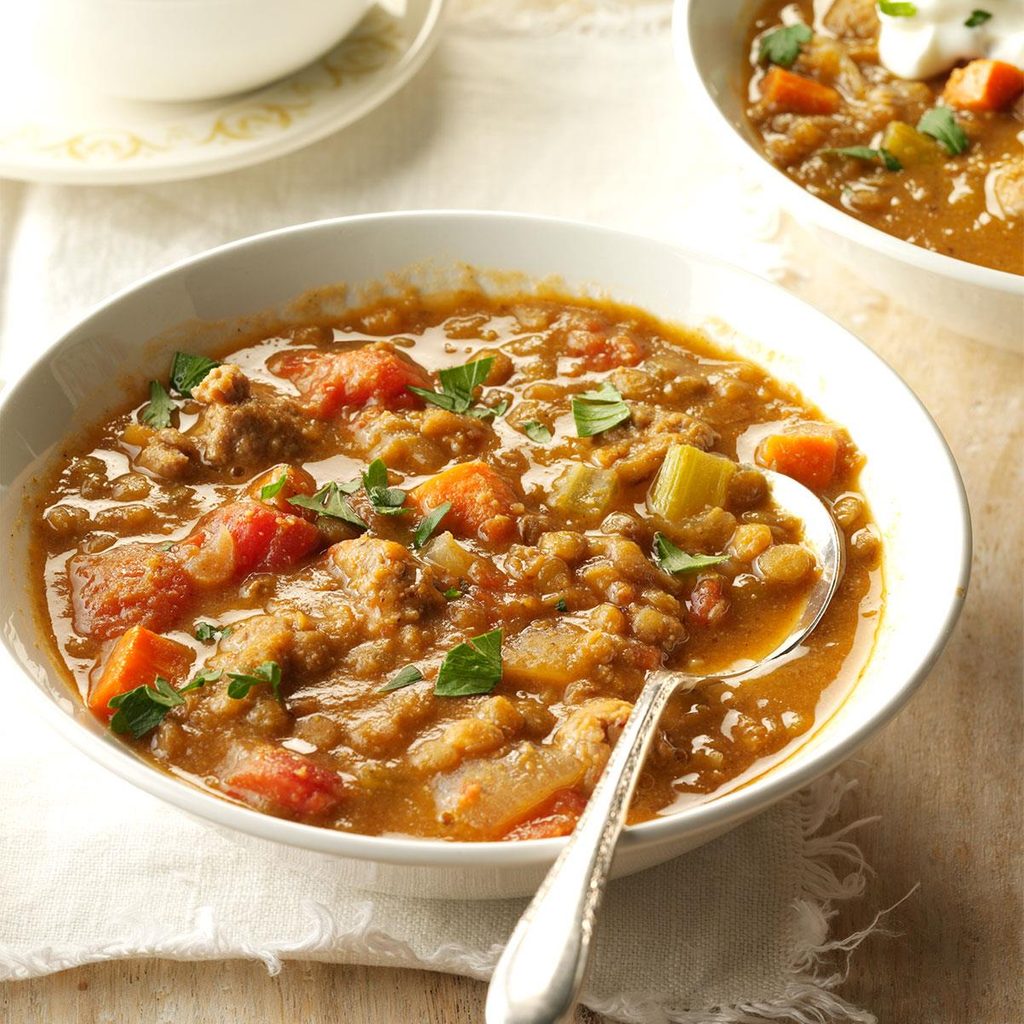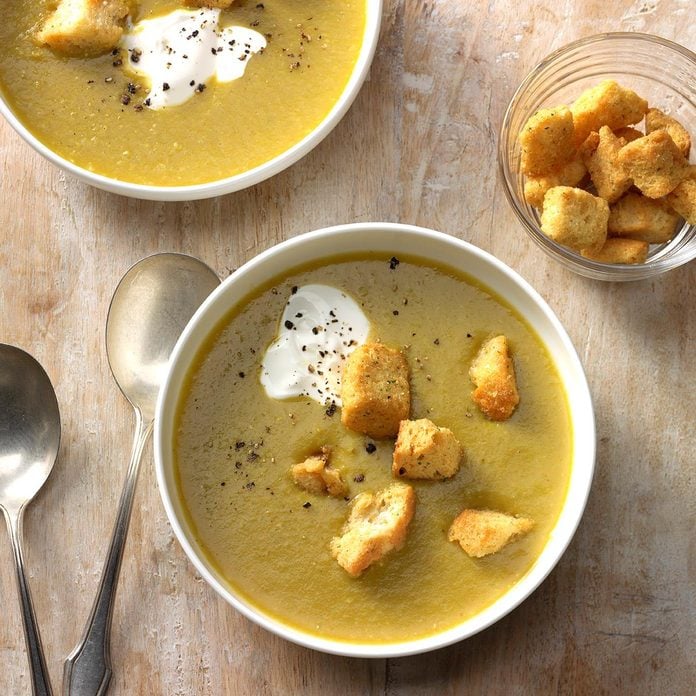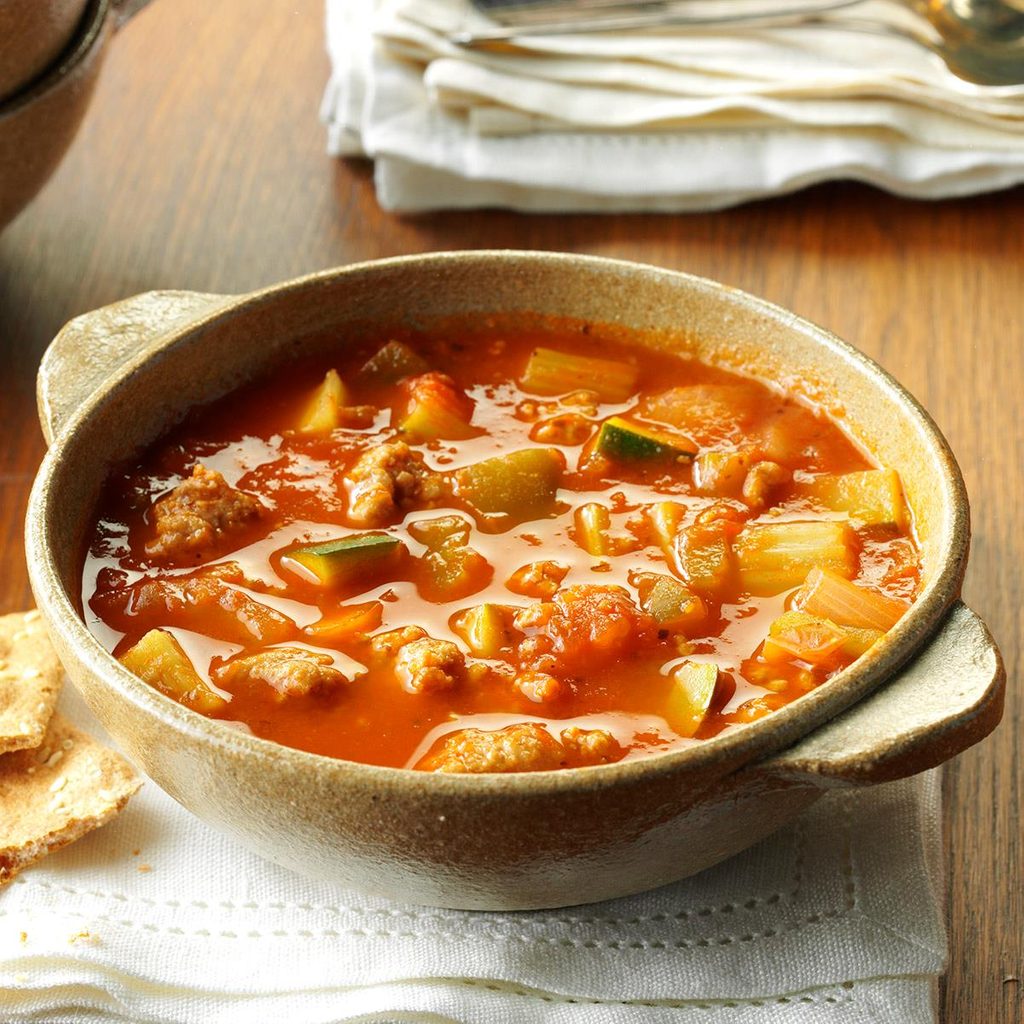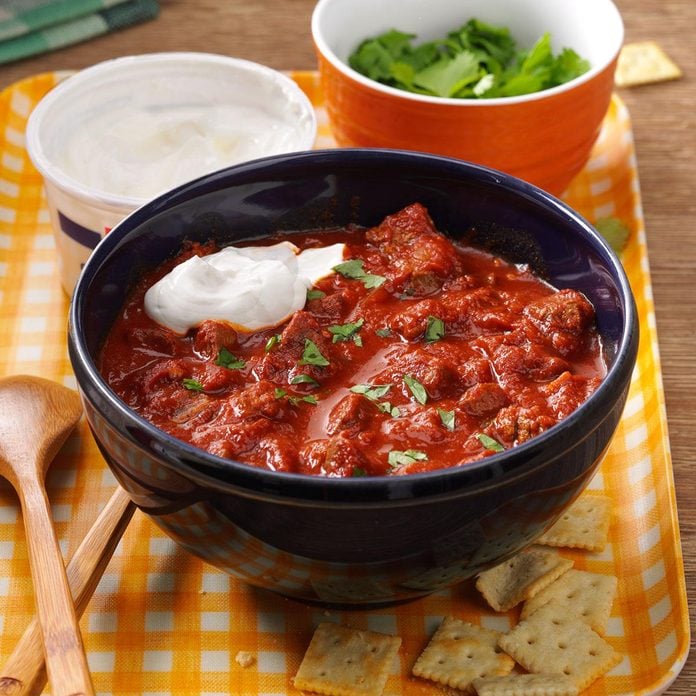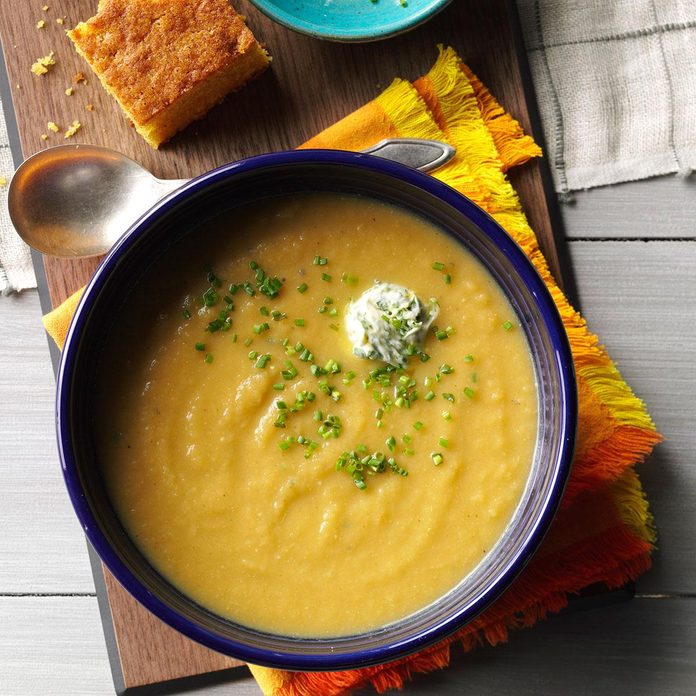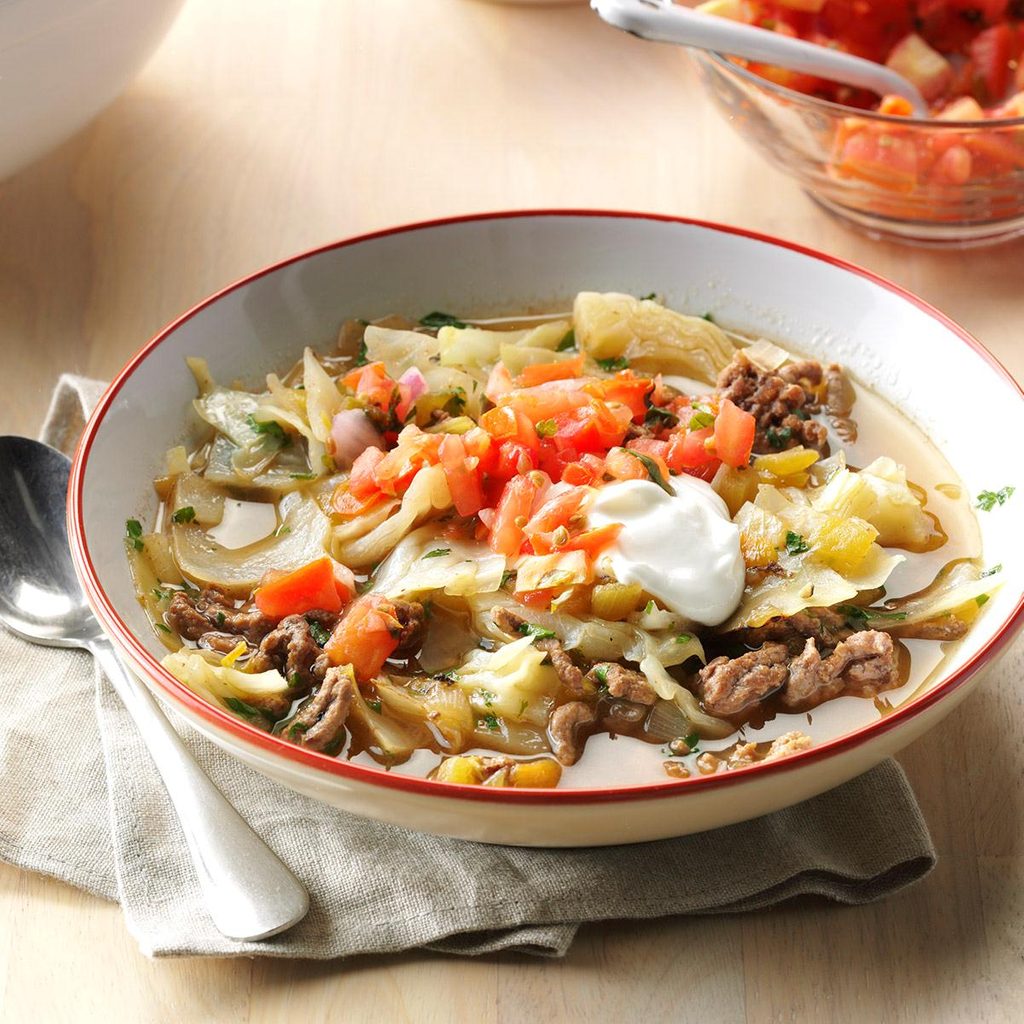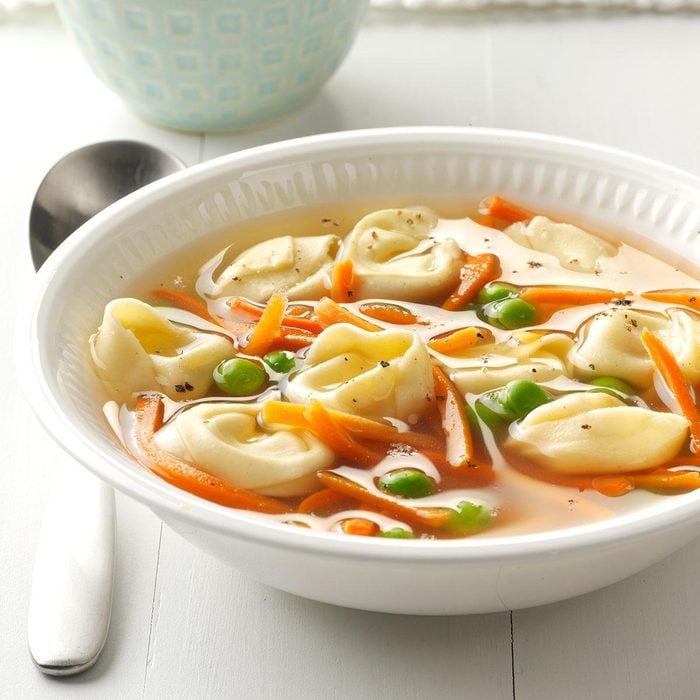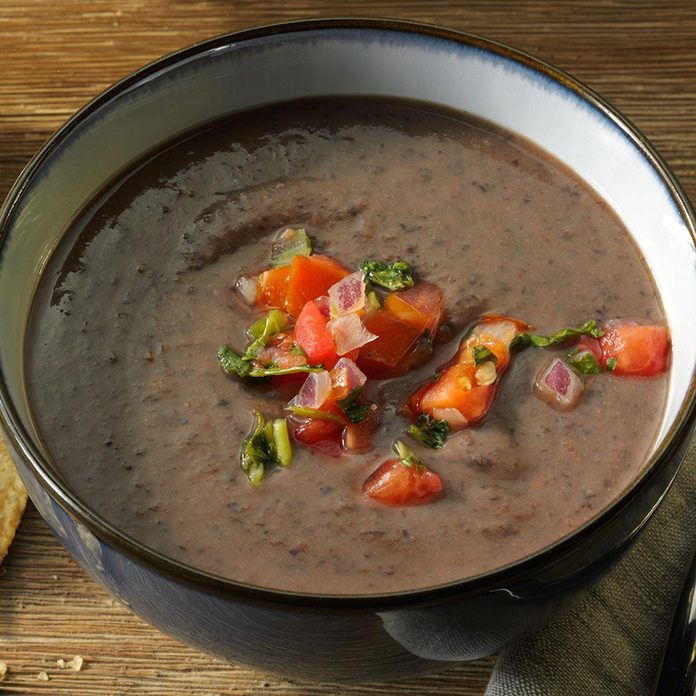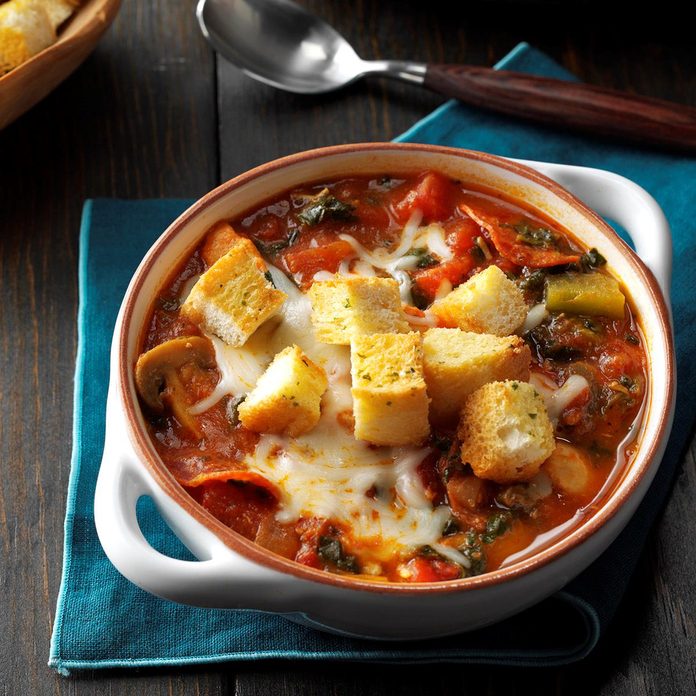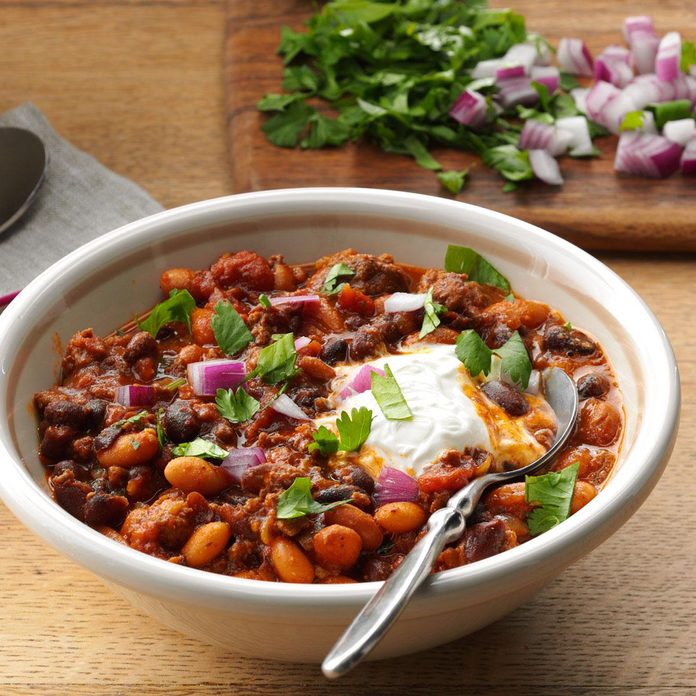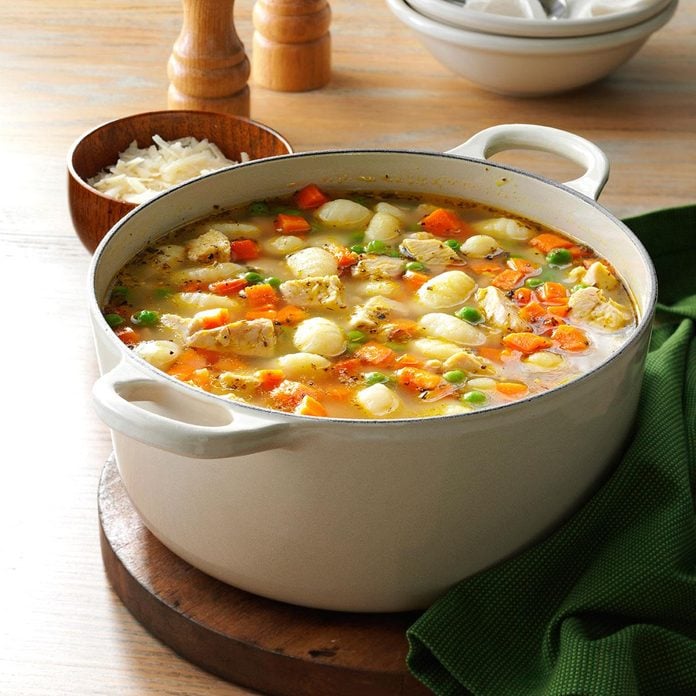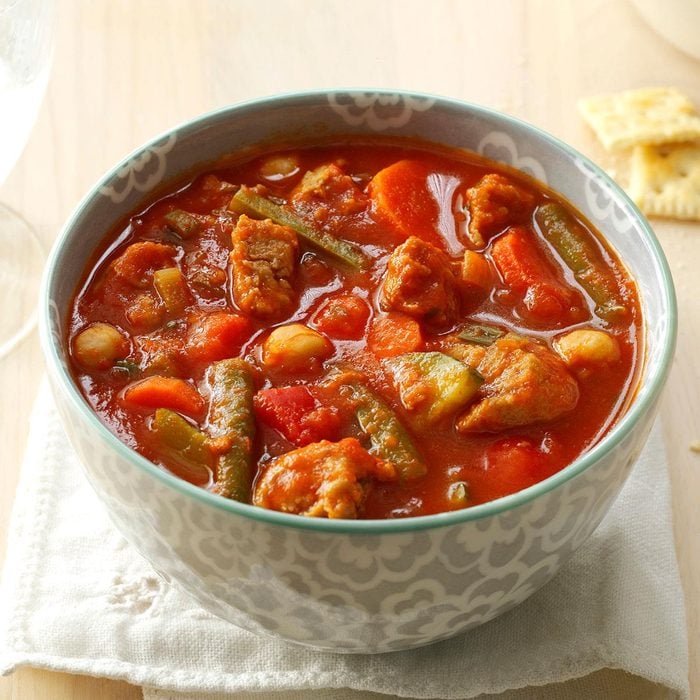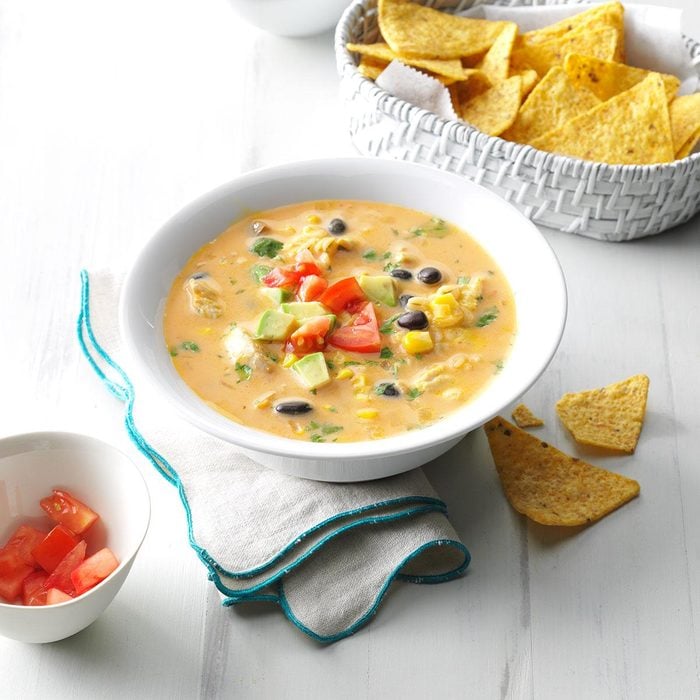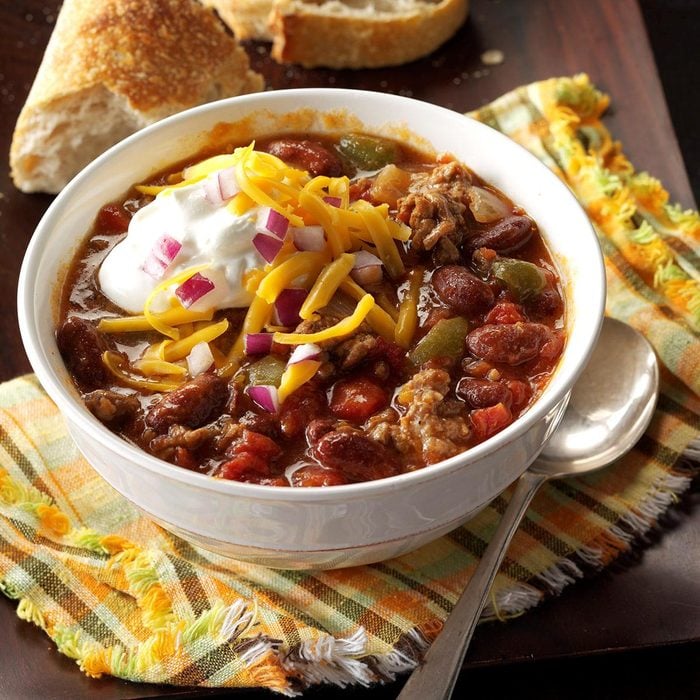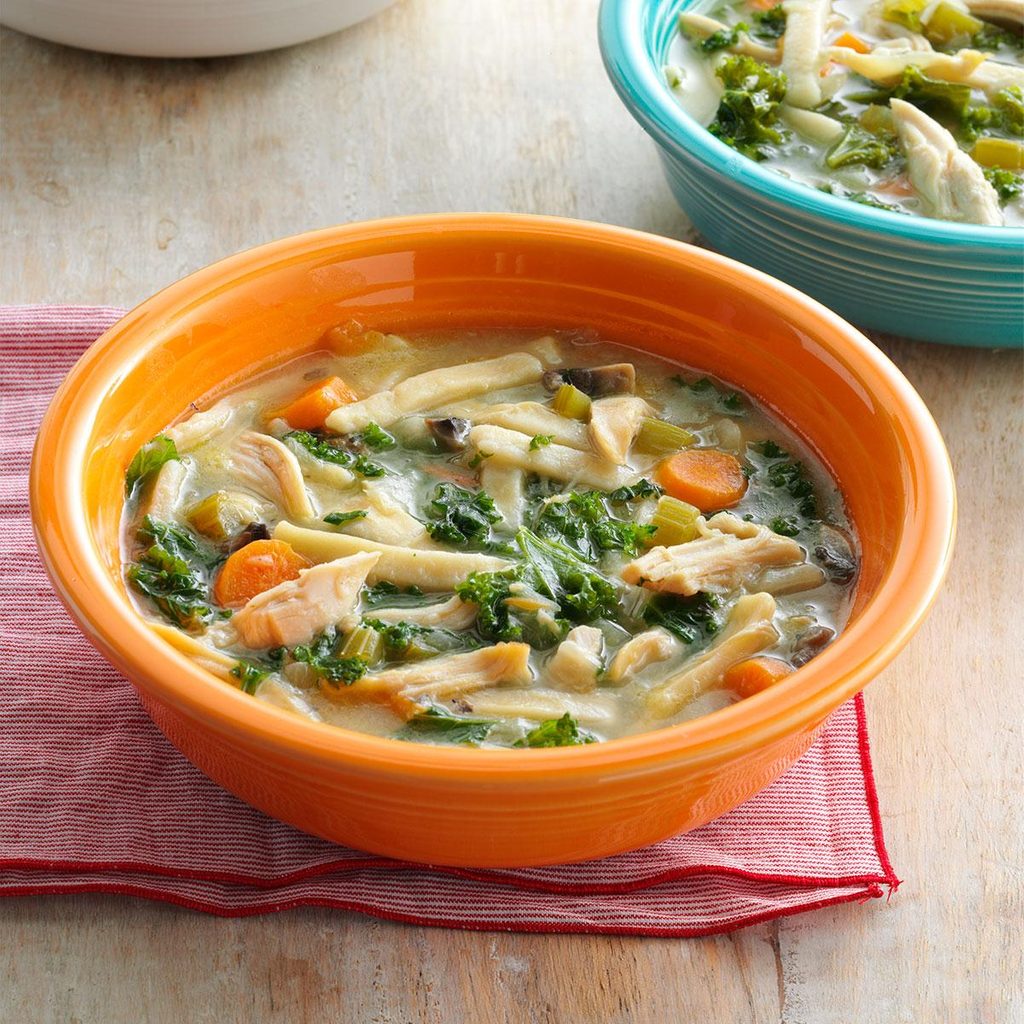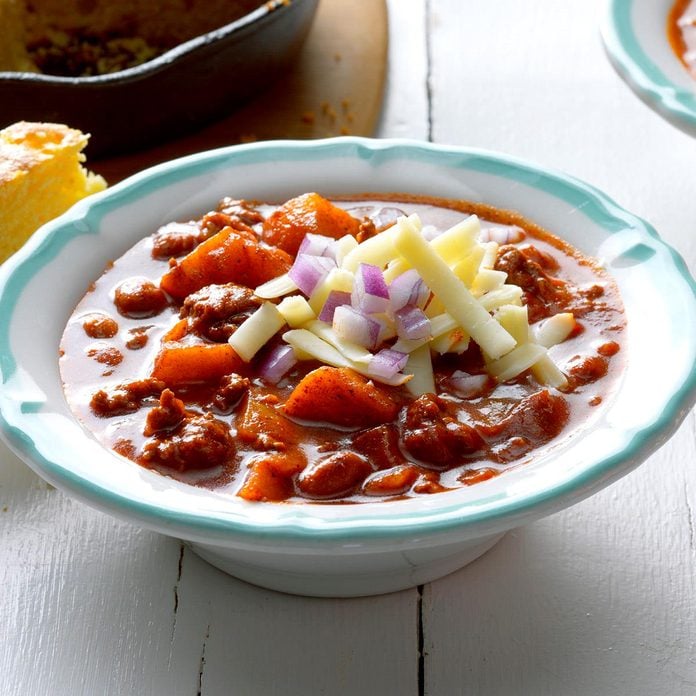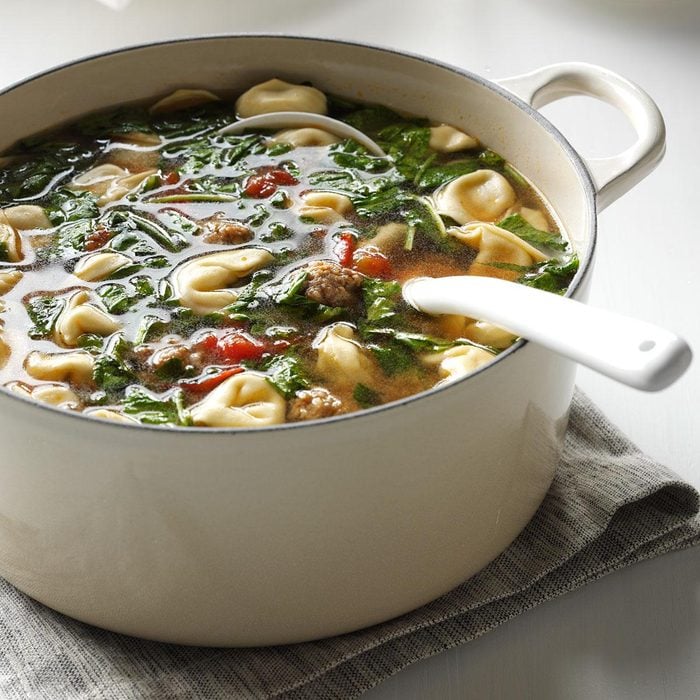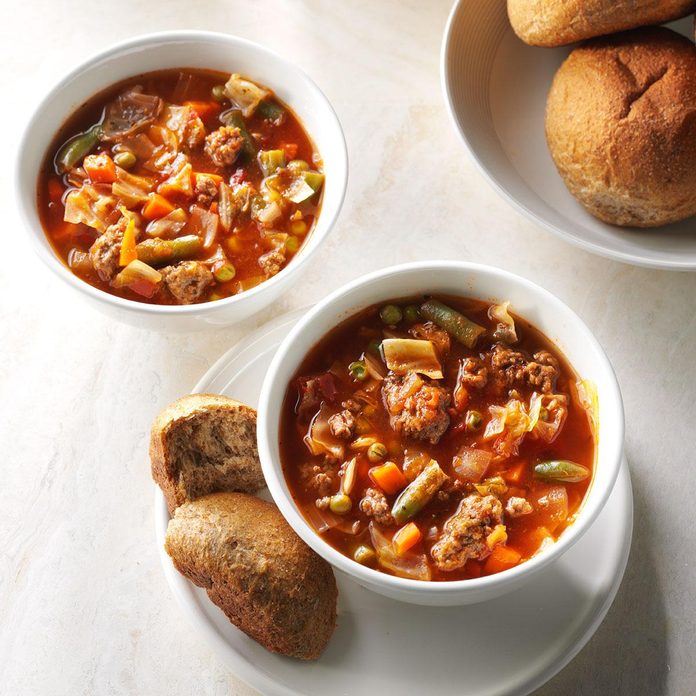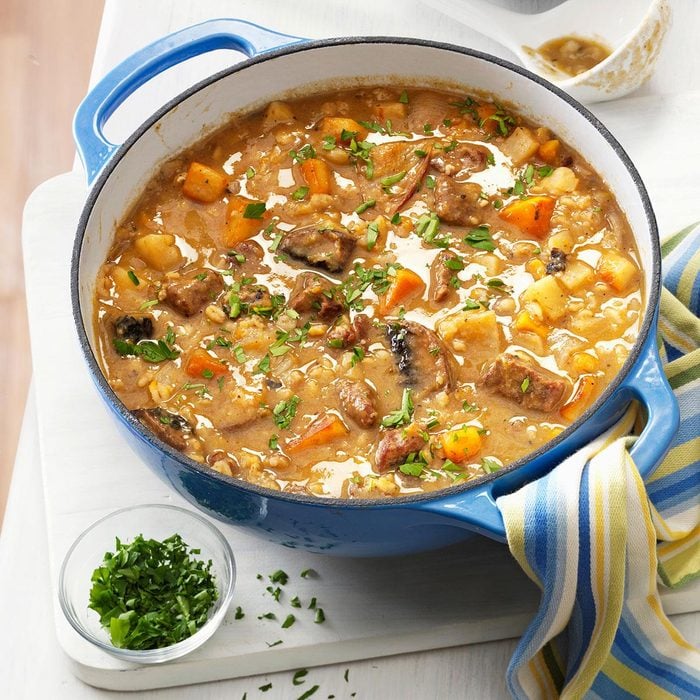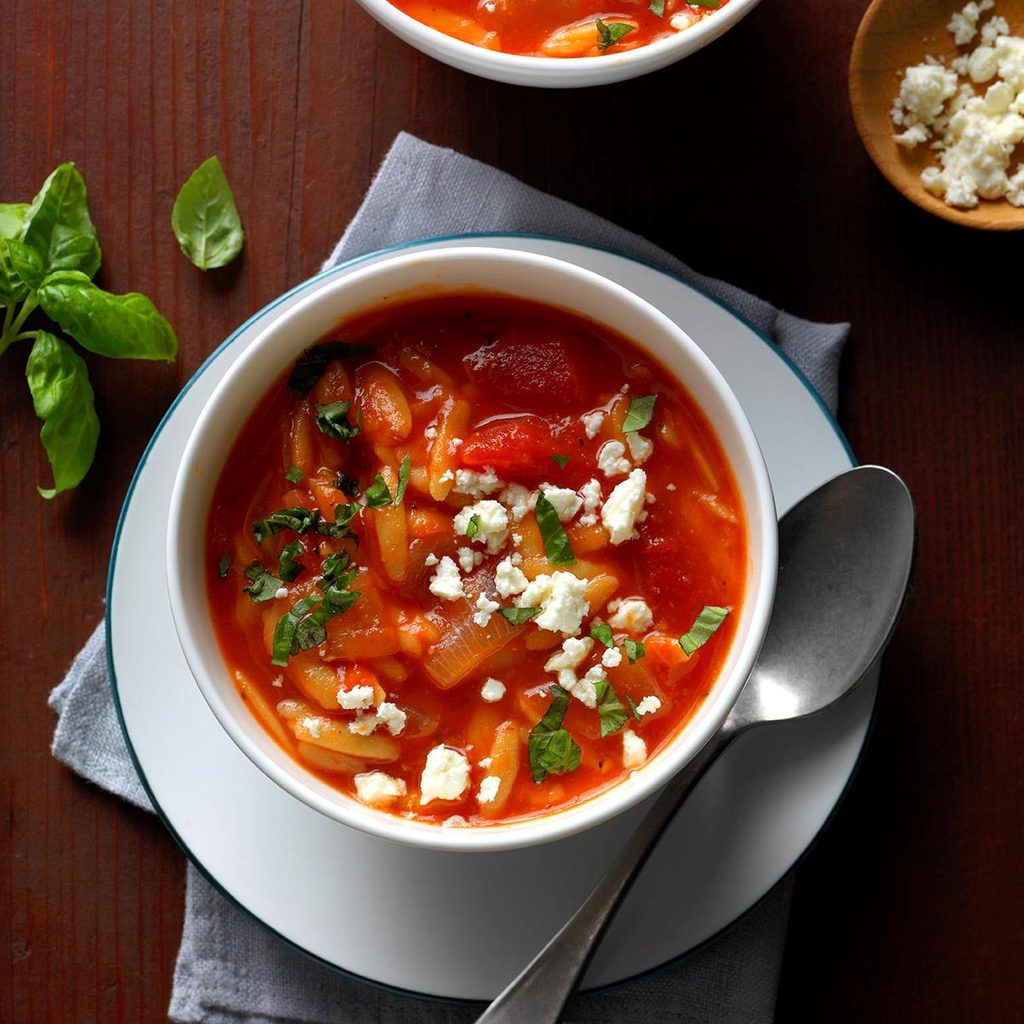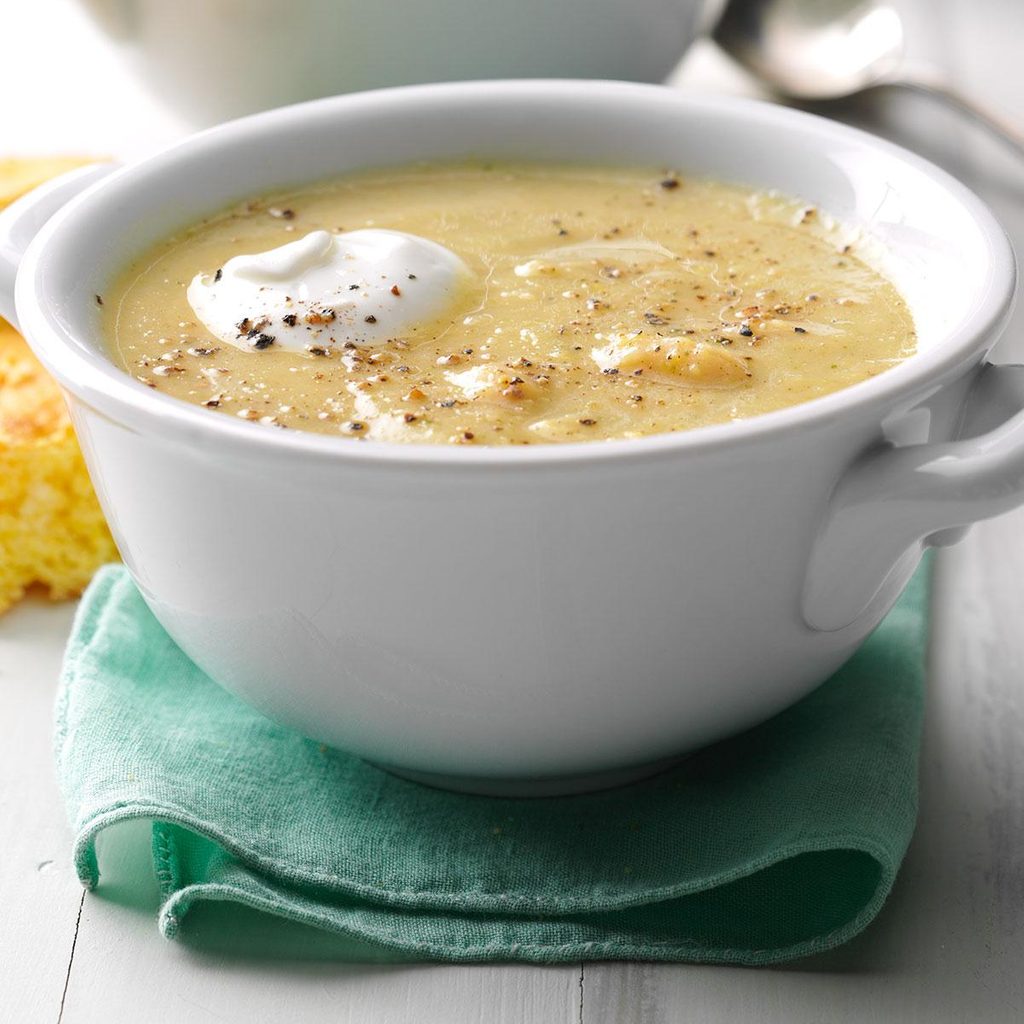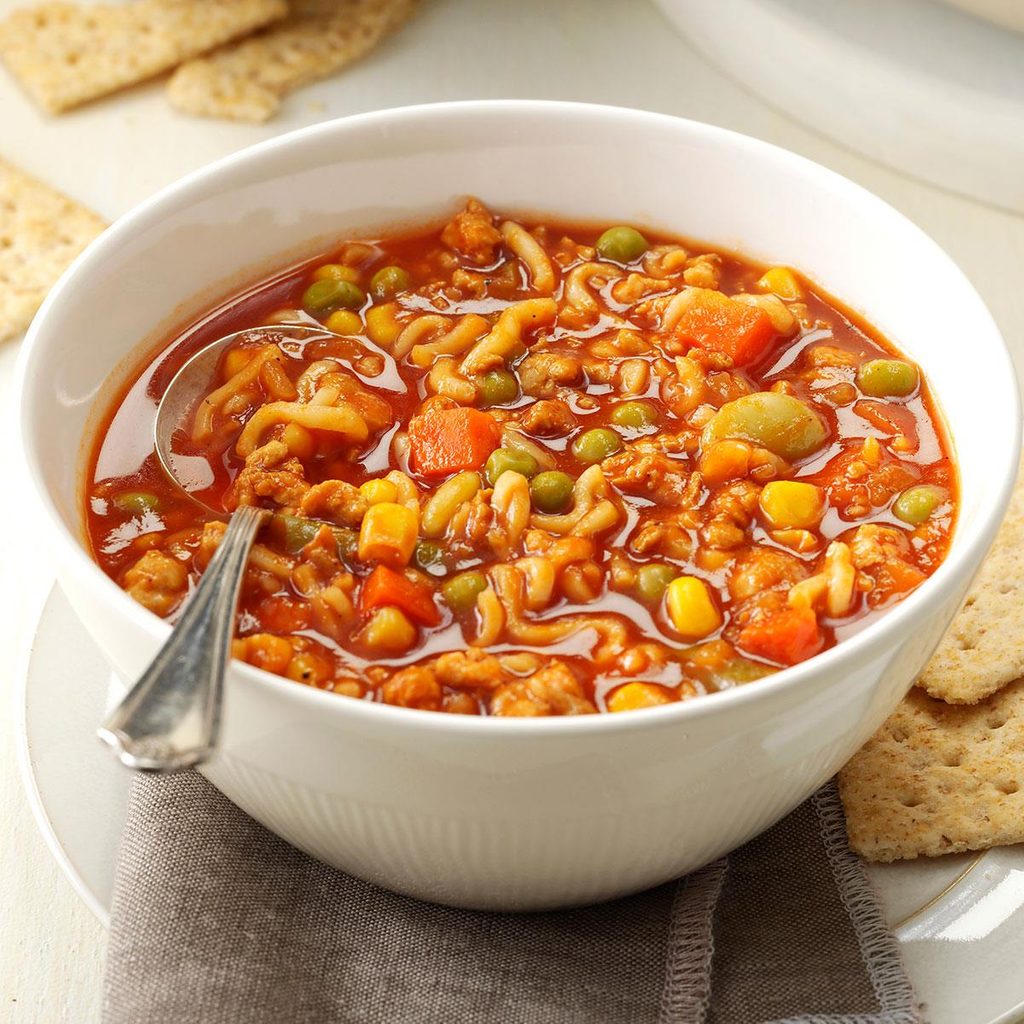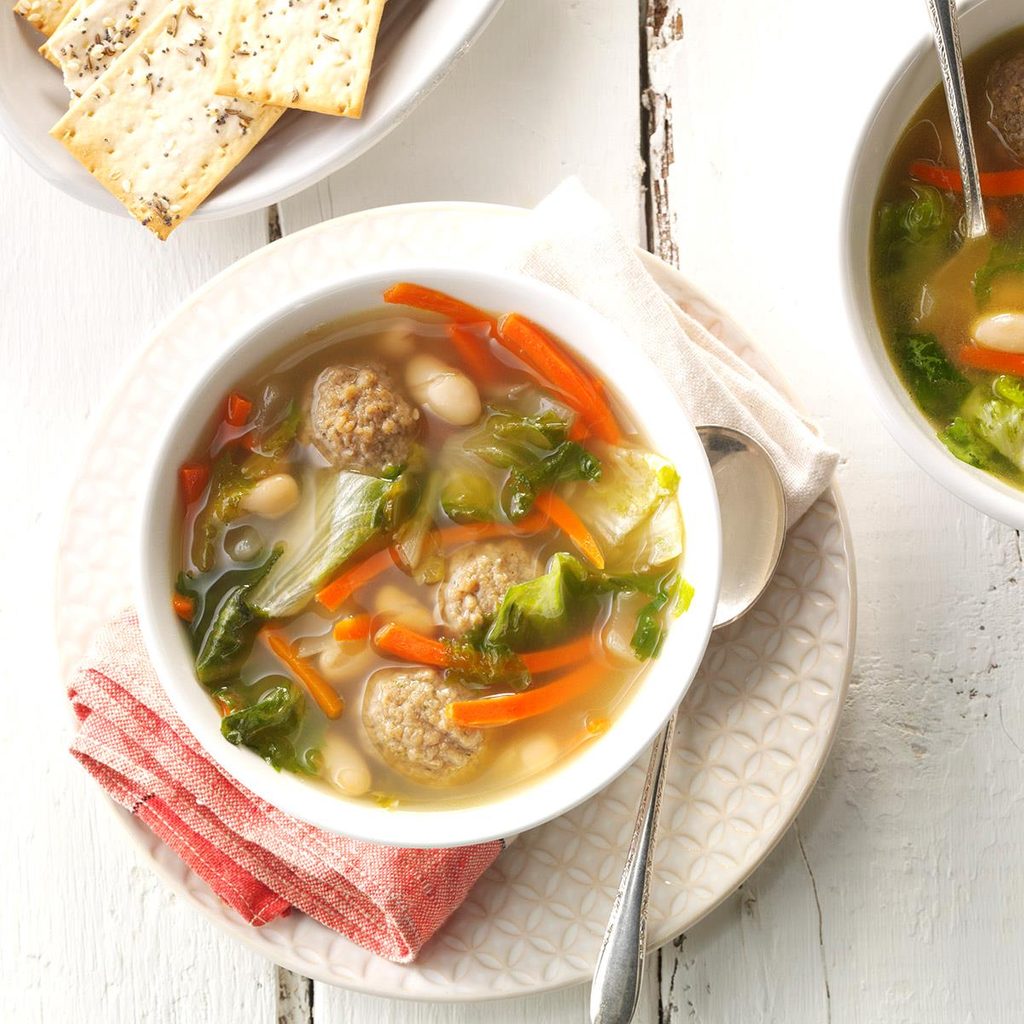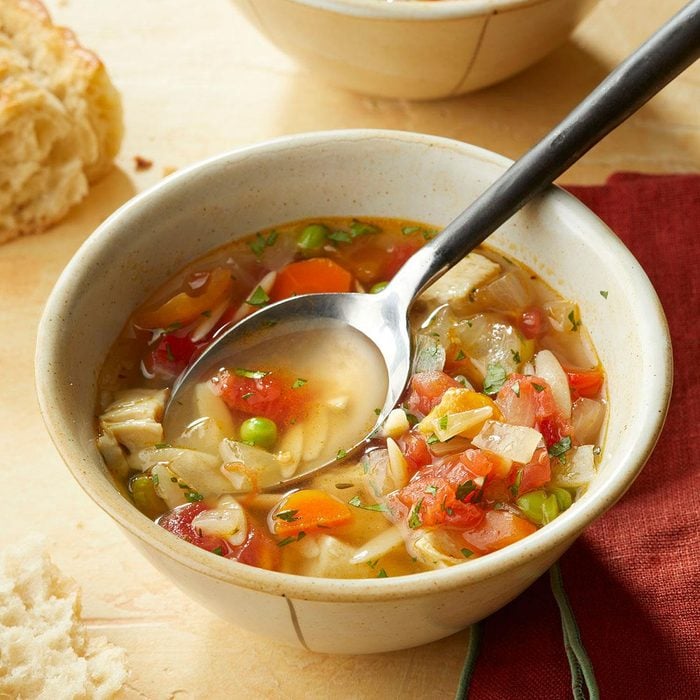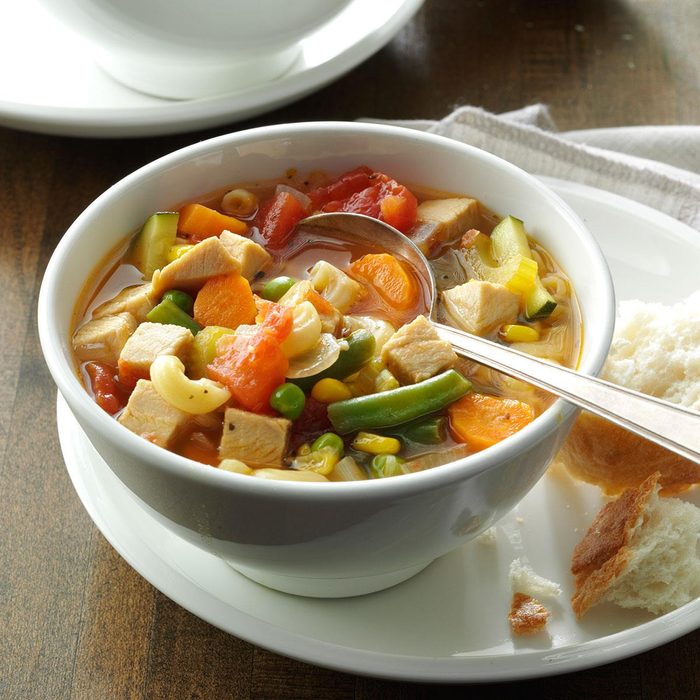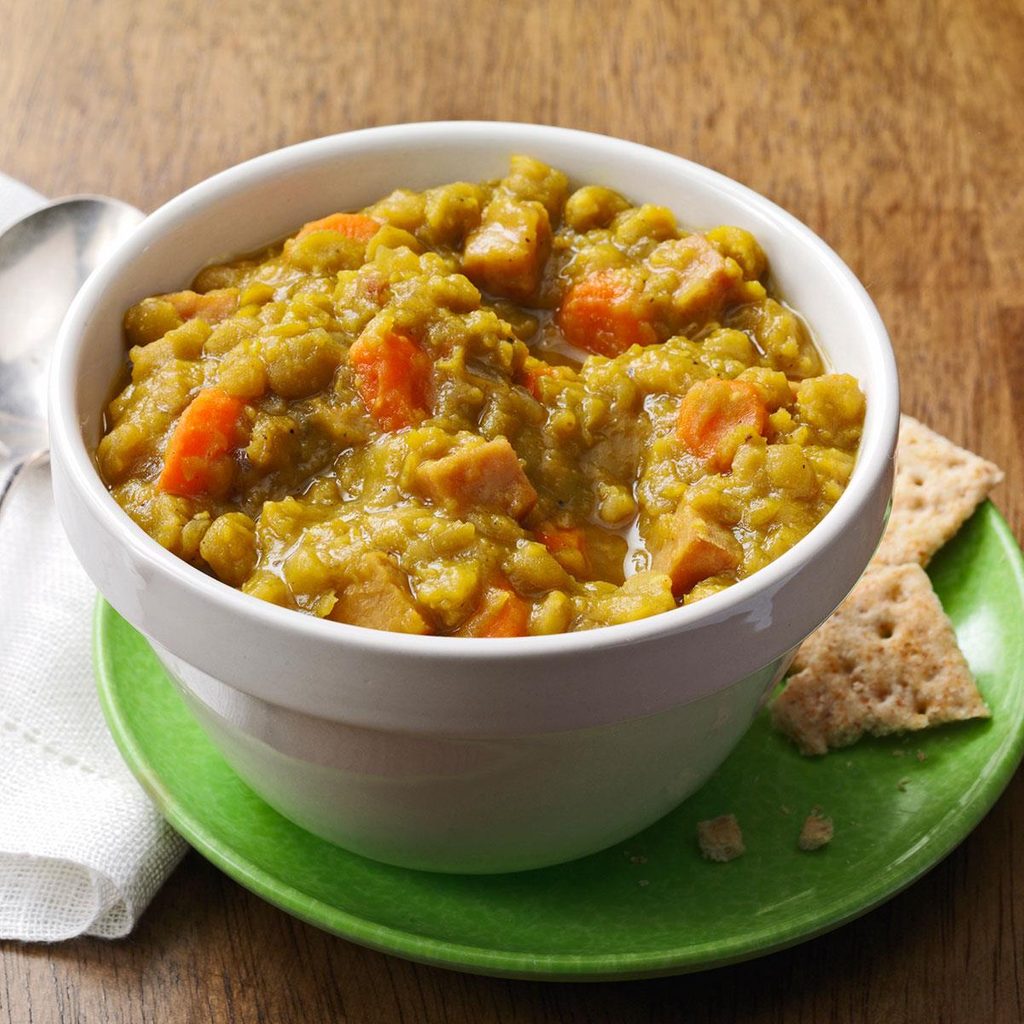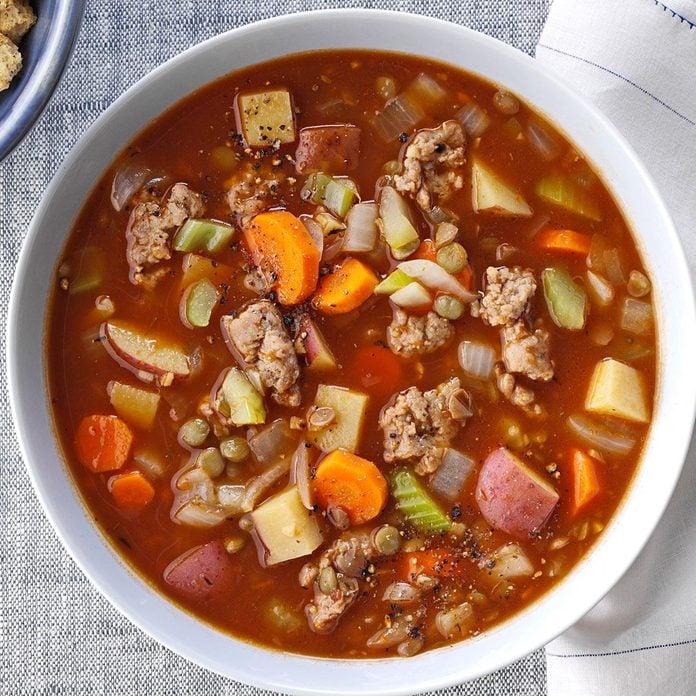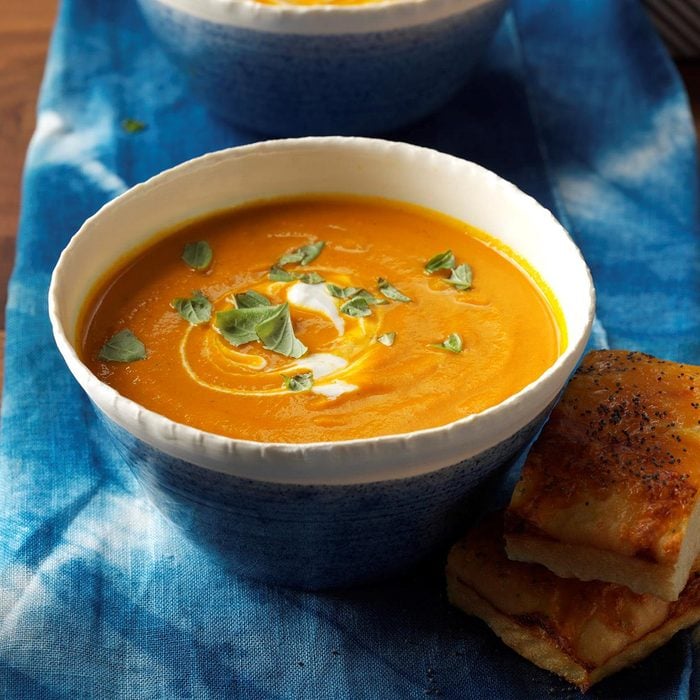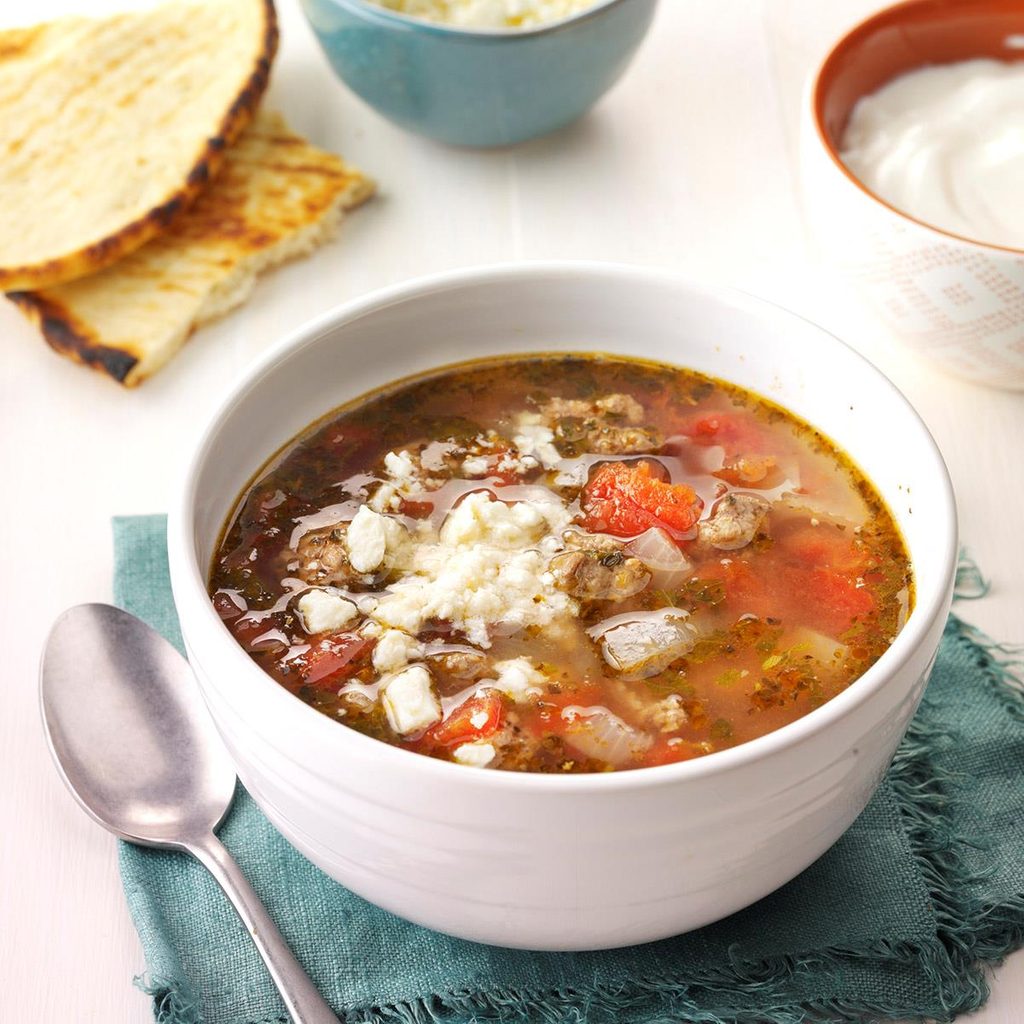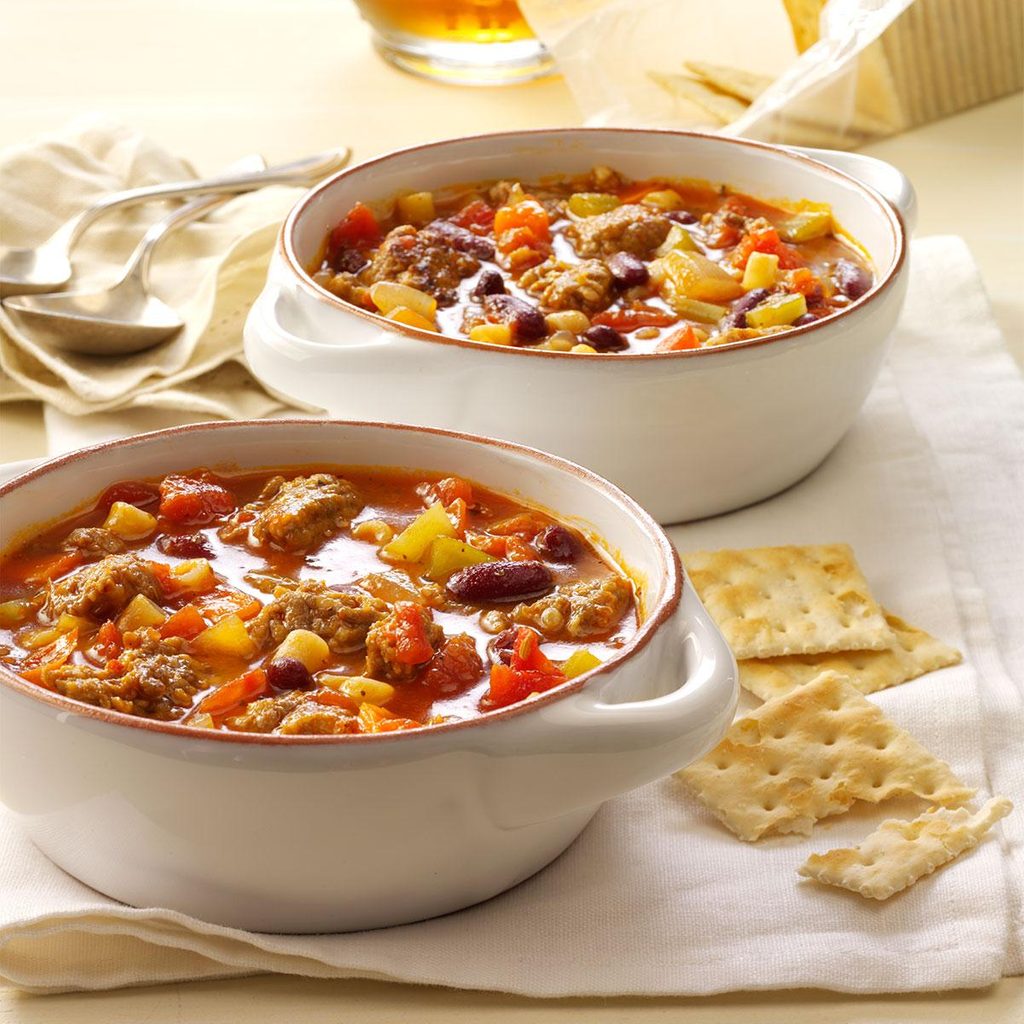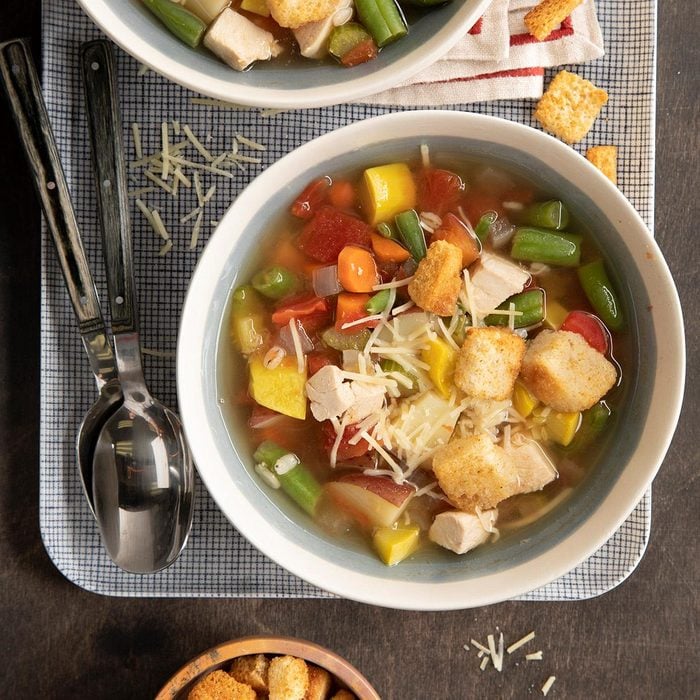White Chicken Chili
Folks will enjoy a change from traditional chili when they dip their spoons into this flavorful blend of tender chicken, white beans and just enough zip. —Taste of Home Test Kitchen
Get Recipe
Hearty Baked Potato SoupI got this recipe from my aunt, a terrific cook. Full of bacon, cheese and chives, the soup tastes just like a loaded baked potato. My husband and I love to hunker down with it on chilly nights. —Molly Seidel, Edgewood, New Mexico
Hunker down this winter with these
hearty soup recipes.
Vietnamese Chicken Meatball Soup with Bok ChoyThroughout Vietnam there are many kinds of soups, “canh,” served all year long. I particularly love enjoying this warm, flavorful bowl of Vietnamese chicken soup on laid-back weekends, but it's also great packed in a Thermos for lunch. It's the perfect bok choy soup, too! —Brenda Watts, Gaffney, South Carolina
Steakhouse SoupEnjoy a steak dinner in a bowl with this super simple, hearty steak soup. Because of the chili powder and cayenne pepper, it packs a little heat, but the recipe can easily be adjusted if you’re cooking for young ones. —Erica Schmidt, Kansas City, Kansas
Still hungry? Find more
tasty soup recipes here.
Garden MinestroneAt Italian restaurants, I always order minestrone. After doing many trial-and-error batches, I developed a hearty veggie soup my whole family craves—kids and all. —Hillery Martin, Junction City, Kansas
Italian Beef Vegetable SoupThis hearty vegetable beef soup features a ton of fresh veggies, making it the perfect dish to use up all that summer produce. It's also fantastic during cooler weather! Make sure you serve this Italian soup with some breadsticks, rolls or flaky biscuits. —Courtney Stultz, Weir, Kansas
Easy Portuguese-Style Bean SoupOne day I was looking at Portuguese recipes and decided to put together a bean soup that embraced the bright and spicy flavors of Portugal. My family liked it so much, it became a classic in our household. To save time and work, the sausage, vegetables and herbs can all be prepped in minutes with a food processor. —Steven Vance, Woodland, Washington
Chorizo and Chickpea SoupChorizo sausage adds its own spice to the broth of this soup, creating delicious flavor with no need for more seasonings. And while it's cooking, the whole house smells divine! —Jaclyn McKewan, Lancaster, New York
Cheesy ChiliMy six grandchildren enjoy feasting on big bowls of this zesty chili. It's so creamy and tasty, you can even serve it as a dip at parties. —Codie Ray, Tallulah, Louisiana
Sausage and Lentil SoupSpicy sausage and chicken broth flavor the milder lentils and beans in this sausage and lentil soup recipe. Tomatoes and spinach add color while goat cheese tops it off with a bit of tanginess.
Slow-Cooker Split Pea SoupSlow-cooker split pea soup is so easy, all you have to do is dump everything into the cooker. This soul-warming soup comes together in a snap!
Mom's Chicken Noodle SoupMy mother was a pastor's wife, and she did a lot of cooking for potlucks. This recipe is one she created herself. I serve it frequently to my husband and to our four children. Every one of them is a hearty eater! —Marlene Doolittle, Story City, Iowa
Slow-Cooked Chicken Enchilada SoupThis crockpot chicken enchilada soup is inspired by the Mexican dish and loaded with southwestern flavors from poblano peppers and enchilada sauce to juicy shredded chicken.
Hearty Butternut Squash SoupThe comforting combination of squash, meat, beans and veggies makes this my go-to soup in fall. It's full of freshness. —Jaye Beeler, Grand Rapids, Michigan
Chicken Fajita SoupThis south-of-the-border chicken fajita soup is a set-and-forget slow-cooker recipe that's a winner at family dinners and potlucks alike. Top it off with fresh avocado, shredded cheddar cheese and cilantro.
Satisfying Tomato SoupAfter craving tomato soup, I decided to make my own. My sister Joan likes it chunky-style, so she doesn't puree. Serve it with a grilled cheese sandwich. —Marian Brown, Mississauga, Ontario
Chunky Chipotle Pork ChiliMy leftover pulled pork chili recipe is a busy cook's dream. Make it ahead and reheat later—it's even better the second day. —Peter Halferty, Corpus Christi, Texas
Slow-Cooker Stuffed Pepper SoupEnjoy all the flavors of traditional stuffed peppers in this hearty Slow-Cooker Stuffed Pepper Soup. With lean ground beef, vibrant green peppers and a rich tomato broth, this easy, slow-cooked dish is perfect for a cozy, comforting meal any night of the week.
Slow-Cooker Sweet Potato SoupI love that I can top this creamy soup with anything my heart desires, which means I can eat it several days in a row without ever having to have it the same way twice. You can substitute fresh onions and celery in this recipe if you prefer, but using the dried version makes it easy to throw together on a weekday morning. —Colleen Delawder, Herndon, Virginia
Italian White Bean SoupHave a refrigerator full of vegetables and a can of beans? That's all you need for a pot of hearty Italian white bean soup.
Sausage & Chicken GumboThis recipe for classic southern comfort food was the first thing I ever cooked for my girlfriend. It was simple to make but tasted gourmet—definitely love at first bite. —Kael Harvey, Brooklyn, NY
Butternut Squash and Barley SoupI love to use my garden produce in this veggie-packed soup. Serve it with bread or oatmeal dinner rolls and you have a delicious, healthy dinner. —Julie Sloan, Osceola, Indiana
Creamy Cauliflower Pakora SoupMy husband and I often crave pakoras, deep-fried fritters from India. I wanted to get the same flavors but use a healthier cooking technique, so I made soup using all the classic spices and our favorite veggie, cauliflower! —Melody Johnson, DePere, Wisconsin
Spicy Peanut Chicken ChiliWhile spending time in the Southwest, I discovered Mexican peanut chicken and thought it would be fun to make it into a chili. Chipotle peppers give it a nice spice that's extra warming on a cold day. —Crystal Schlueter, Northglenn, CO
Traditional Italian Wedding SoupThis recipe for Italian wedding soup results in a truly flavorful, satisfying dish.
Split Pea Soup with Bacon & CrabMany split pea soups use ham and bacon for good, smoky flavor. Taking it one amazing step farther-add crabmeat. Freeze this one without toppings (freeze the cooked bacon separately), then reheat soup in a saucepan. Feel free to add more chicken stock or broth when reheating if you need it. Sprinkle bacon and fresh crab on top of bowls of hot soup. —Stephen Exel, Des Moines, Illinois
Carrie’s Cincinnati ChiliEvery time we have a gathering or company, folks request this. My husband convinced me to enter it in a local chili contest, and I won third place! It's quick and easy. If I don't have fresh garlic, I use minced garlic from a jar. —Carrie Birdsall, Dallas, Georgia
Roasted Cauliflower & Red Pepper SoupWhen cooler weather comes, soup is one of our favorite meals. I developed this recipe for my husband and me. I wanted it to be a healthier version of all the cream-based soups out there. After a bit of trial and error, this is the keeper. —Elizabeth Bramkamp, Gig Harbor, Washington
Turkey Sausage and Lentil SoupThis recipe was given to me by my son, Chris, and we have it several times during the winter months. —Kathy Mazur, Sarasota, Florida
Simple Asparagus SoupMy family and friends love this soup. It's elegant and unusual, but the hardest part of making it is occasional stirring. —Kathryn Labat, Raceland, Louisiana
Italian Sausage Zucchini SoupMy mom used to make this recipe. Whenever I decide to make it, it reminds me of her, taking me back to days of my childhood. —Louise Kline, Fort Myers, Florida
Chipotle Beef ChiliI love spicy food, so I think this chili really hits the spot. If you are sensitive to chile peppers, start out with one or two chipotles and go up from there. —Steven Schend, Grand Rapids, Michigan
Autumn BisqueI like cozy comfort soups that taste creamy—without the cream. This one’s full of good stuff like rutabagas, leeks, fresh herbs and almond milk. —Merry Graham, Newhall, California
Mexican Cabbage Roll SoupI love sharing our humble and hearty soup made with beef, cabbage and green chiles. A blast of cilantro gives it a sunshiny finish. —Michelle Beal, Powell, Tennessee
Tortellini Primavera SoupYears ago, I found the idea for tortellini with peas and carrots in a magazine. I added my own touch to it. —Kari George, Ellicott City, Maryland
Pico de Gallo Black Bean SoupEveryone at my table goes for this feel-good soup. It is quick when you’re pressed for time and beats fast food, hands down. —Darlis Wilfer, West Bend, Wisconsin
Pizza Soup with Garlic Toast CroutonsThis comforting soup satisfies our pizza cravings. It's super versatile, too, and I sometimes substitute light Italian sausage for the chicken or add a little Parmesan cheese. Go nuts and add all your favorite pizza toppings! —Joan Hallford, North Richland Hills, TX
If you're interested in a viral recipe, you won't want to miss out on this internet famous
pizza soup.
Slow-Cooker Turkey ChiliI love this slow-cooker turkey chili recipe. Surprise ingredients like coffee and wine give it a rich, deep flavor that we balance by topping it off with avocado and green onion. Make a big batch and freeze any leftovers! —Terri Crandall, Gardnerville, Nevada
Weeknight Taco SoupThis soup turned out delicious on the first try, when I was working without a recipe. You could also add cooked ground beef or cubed stew meat dredged in seasoned flour and browned for a heartier meal. —Amanda Swartz, Goderich, Ontario
Bean & Beef Slow-Cooked ChiliThis chili may be already chock-full, but we love to build it up even more with toppings like pico de gallo, red onion, cilantro and cheese. —Mallory Lynch, Madison, Wisconsin
Chicken Veggie SoupThis satisfying veggie soup hits the spot at lunch or dinner. Add a side salad and some whole grain bread for a delicious, nutritious meal. —Amy Cheatham, Sandusky, Ohio
Turkey Gnocchi SoupWhile trying to find a creative use for leftover turkey, we decided to add gnocchi instead of noodles. My 8-year-old daughter always asks for more. If you don't have leftover turkey, a rotisserie chicken works just as well. —Amy Babines, Virginia Beach, Virginia
Turkey Sausage Soup with Fresh VegetablesOur family is big on soup. This favorite is quick to make and very tasty, and it gives me plenty of time to have fun with my kids and grandkids while it slow-cooks. —Nancy Heishman, Las Vegas, Nevada
Southwest Chicken Barley ChowderMashed squash helps make this chowder creamy but not heavy, and it's a favorite way to get barley on the table. My kids even ask for leftovers for lunch. —Pamela Cleghorn, Campbellsburg, Indiana
Taco ChiliRanch dressing mix is the secret ingredient that makes this Mexican taco chili recipe so amazing that guests will wonder how you made it. To make things even better, the chili practically cooks itself in a slow cooker once you've browned the beef.
Italian-Style Lentil SoupA nutritious, inexpensive source of protein, lentils are low-fat, lens-shaped seeds that are delicious in salads, sides and soups, like our Italian-style lentil soup that's cozy, comforting and packed with nutrients.
Broccoli Beer Cheese SoupWhether you include the beer or not, this soup tastes wonderful. I always make extra and pop individual servings into the freezer. —Lori Lee, Brooksville, Florida
Easy White Chicken ChiliEasy white chicken chili comes together with hearty beans, ground chicken and a creamy broth. Dried herbs and chopped green chiles are all you need to season this comforting dish.
Apple Squash SoupI add a little ginger and sage to this creamy butternut squash apple soup. My family loves it when autumn rolls around. —Crystal Ralph-Haughn, Bartlesville, Oklahoma
Beef and Sausage ChiliThanks to multiple meats, a generous helping of beans and the classic chili trifecta of tomatoes, onions and peppers, this slow-cooker beef and sausage chili is tender, filling and oh so tasty.
Homey Chicken Noodle SoupChicken noodle soup brings back memories of childhood. This revamped version with a healthy twist is a favorite at my house, especially after we've been working outside on a cool day. It takes the chill off.—Cynthia LaFourcade, Salmon, Idaho
Spiced Apple ChiliNothing says fall like chili and apples. I use smoked paprika to give this slightly sweet chili a smoky kick. —Joyce Moynihan, Lakeville, Minnesota
Spicy Sausage Soup with TortelliniThis soup is such a family treasure, both my daughters asked for the recipe when they moved out on their own. I cook the tortellini separately, but you can let it plump up in the soup broth, too. —Cynthia Krakowiak, Langhorne, Pennsylvania
Italian Veggie Beef SoupMy sweet father-in-law, Pop Pop, would bring this chunky soup to our house when we were under the weather. We like it so much, we take it to our own friends who need comfort. It always does the trick. —Sue Webb, Reisterstown, Maryland
Beef Barley Soup with Roasted VegetablesThe beauty of this soup is that you can roast the vegetables separately in the oven while it's simmering away. Then simply add them in during the last minutes on the stovetop. I love that the roasted vegetables keep their own bright flavors that add to this earthy bowl of warmth. —Gayla Scott, West Jefferson, North Carolina
Game-Stopper ChiliThis hearty chili with sausage, beef, beans and barley is perfect for the halftime food rush. People actually cheer when they see me coming with my slow cooker! —Barbara Lento, Houston, Pennsylvania
Greek Tomato Soup with OrzoMy recipe for manestra, which means orzo in Greek, is effortless and very easy to make. You need only a few steps to transform simple ingredients into a creamy one-pot wonder. —Kiki Vagianos, Melrose, Massachusetts
Summer Squash & White Bean SoupI love using summer squash in soups. This dish is hearty as is, but stir in chopped ham for an extra wallop of flavor. Serve it warm or chilled. —Sara Hornbeck, Knoxville, Tennessee
Turkey and Black Bean ChiliTypical chilis require hours of cooking, but this turkey and black bean chili recipe can be made in a quick 30 minutes. There's still plenty of flavor, though, thanks to an all-star list of spices and nourishing, tasty ingredients.
Minestrone SoupThis minestrone soup recipe is packed with vegetables, pasta and beans in a bright tomatoey broth. It ticks all the boxes: It's hearty, incredibly comforting and a breeze to make!
Butternut Squash and Sweet Potato SoupCreamy butternut squash and sweet potato soup is chock-full of flavor, nutrients and warming ingredients. Easy to make, using just one pan and an immersion blender, it's the ideal soup for cold nights.
Turkey & Noodle Tomato SoupTurn V8 juice, veggies and ramen noodles into a wonderful soup that takes just a few minutes to make. I like to serve it with biscuits. —Jennifer Bridges, Los Angeles, California
White Bean Soup with MeatballsIt tastes like it's from scratch, but my Italian-inspired soup uses lots of shortcuts. For a meatball in every bite, chop them up—with an egg slicer! —Carole Lotito, Hillsdale, New Jersey
Turkey-Vegetable SoupSomething to be thankful for: turning leftover holiday turkey into this delicious turkey-vegetable soup. Chock-full of herbs, vegetables and orzo, it’s perfect for lunch or dinner.
White Bean Soup with EscaroleThis escarole and bean soup recipe is tasty enough to make everyone forget how healthy it is. Better yet, it's quick and easy.
Minestrone with TurkeyI remember my mom making this soup; now I make it for my kids as often as I can. It's a good way to use up leftover vegetables. Sometimes I add a can of rinsed and drained kidney or garbanzo beans. —Angela Goodman, Kaneohe, Hawaii
Curried Ham & Split Pea SoupThis soup is great for stocking in the freezer and the curry gives it a warmer flavor, which goes so nicely with the salty ham. —Trisha Kruse, Eagle, Idaho
Green Chicken ChiliThis green chicken chili recipe is loaded with tender shredded chicken and hearty navy beans. The spice level can be adjusted by adding extra chiles or finishing the dish with cooling sour cream.
Chunky Sausage Lentil SoupLentils are an inexpensive but nutritious power food, and these days, a hot, filling and flavorful family meal at a great price is a real comfort. My husband just loves this soup and it freezes well. —Donna Scarano, East Hanover, New Jersey
Creamy Carrot & Tomato SoupI often double this recipe and freeze half so we can enjoy a taste of summer during the cold winter months. If I do freeze it, I omit the yogurt and stir it in after the soup's reheated. —Sue Gronholz, Beaver Dam, Wisconsin
Gyro SoupIf you’re a fan of lamb, don’t pass up this Greek-style soup. Seasoned with classic flavors of rosemary, marjoram and mint, it will transport you straight to the Mediterranean! —Bridget Klusman, Otsego, Michigan
Hearty Sausage MinestroneAs a teacher, I appreciate quick and easy recipes. If I make this for just my husband and me, we have leftovers for lunches. But when there are more people at the table, every bit is eaten. —Tami Stoudt, Evans, Colorado
Slow-Cooker Butternut Squash SoupMake this comforting slow-cooker butternut squash soup recipe with ease. It requires just 20 minutes of prep time and offers leftovers that last the entire week.
Stone Soup RecipeAfter reading the Stone Soup story, our Test Kitchen enjoyed concocting this version of the folktale classic. It’s chock-full of veggies and lots more ingredients…enough for everyone to bring something to add to the fun and flavor!


